Monthly Theme Archive
Each month we publish a piece of work which captures the spirit of the current month and season. Anyone can submit either an article or a series of photographs. It must be your own work and cannot include images or text from other authors. Please submit a contact form for further details or send us an email.
August 2025 Theme
When the Views Are Perfect but the Mind Is All Over the Place.
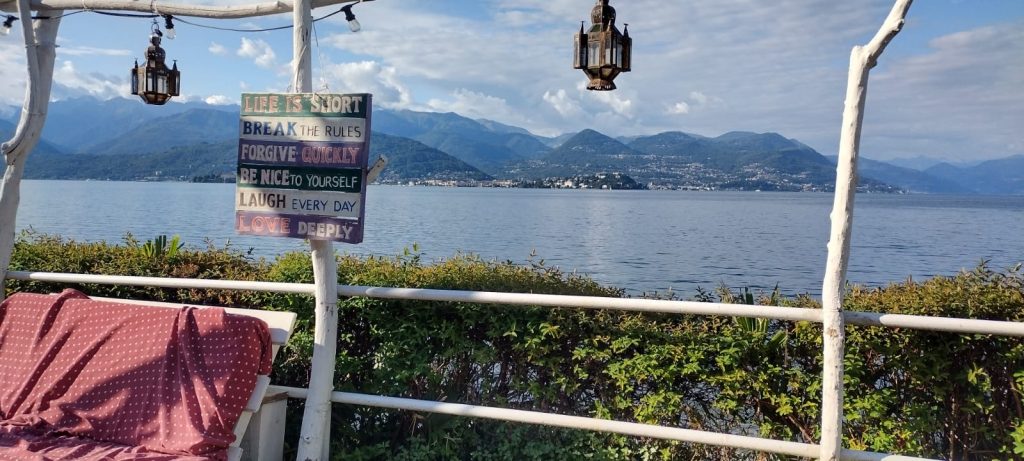
Words and Image by David Glover
I’ve just come back from a holiday in Stresa—a quiet town on the banks of Lake Maggiore, about 50 km from Milan. It’s the kind of place that draws you in slowly, like the best holidays do.
It’s also the kind of place that’s drawn in people like Ernest Hemingway, George Bernard Shaw, John Steinbeck, Claude Debussy, and Arturo Toscanini. Artists and thinkers who’ve wandered its cobbled streets, soaked up its stillness, and created magic.
But I have a problem with holidays. It’s not the sun, or the travel, or my dodgy Italian. It’s the disconnection—from my daily rhythm, from my yoga practice, and from a quiet space to simply sit and breathe.
I don’t mean fancy yoga studios or incense-laced rituals. I mean the basic need to start my day with 20–30 minutes of stillness. And it turns out, that’s surprisingly hard to find when you’re away. No quiet corner, no room that doesn’t echo with footsteps or blaring music, no shady spot without people walking past every two minutes.
I love holidays. But I also end up feeling a bit… scattered. Inspired, yes. But also slightly depleted. It reminds me of something I read by Swami Gyan Dharma in his book Centred in the Now. He asks a simple but unsettling question:
How would you feel if you had no home to return to—not physically, not spiritually? No place to go to. No place to return to.
That struck a chord. Because it’s not just about having a quiet room or a yoga mat. It’s about having a home base—somewhere inside yourself that you return to, no matter where you are in the world. A place not made of bricks, but of breath, mantra, body-awareness. Or whatever works for you.
And when we don’t have that—when we haven’t cultivated that inner home—the mind tends to scatter. It grabs at the next plan, the next destination, the next distraction. Even in paradise.
So yes, it’s important to find a physical space where you can sit undisturbed. But even more important is building that inner anchor. And holidays are actually the perfect test: if you can stay steady there, you can stay steady anywhere.
If you’re travelling soon—or even if you’re not—this is your invitation to reclaim a few minutes each day just for that. To build your internal home, so that no matter where you are, you can come back to yourself.
To help with that, here’s a short 10-minute guided meditation designed to anchor you in stillness. Take it with you on holiday. Or use it right now, at home. You don’t need much. Just a seat, a bit of quiet space, and the intention to stop for a moment.
👉 [Click here to listen to the meditation]
Happy holidays—and happy coming home.
July 2025 Theme
Coming to our senses
Words by Mary Garvey

July, the month named in 44 BCE after Julius Caesar, is associated with being the hottest month in the Northern Hemisphere. In reality, we often experience fluctuating temperatures and weather conditions, which make us feel like we are melting one minute, then searching for extra layers of clothing and our raincoats the next! It can be a busy time with the culmination of the ending of the school year, with lots of extra events and social gatherings, holiday preparations, and juggling of work and childcare responsibilities. Time can feel like it’s been stretched and contorted out of all its usual dimensions, and we just keep running out of it. Then add in the flavour of the Christmas rush that we vow every year to avoid, we have the perfect recipe for losing our own inner connection in the rush of July.
Interestingly, one of July’s flowers is the water lily; not unlike the lotus, it rises up through the mud and murk towards the light: to emerge and flower. A reminder that from the murkiest waters, transformation and change can occur – that journey can bring us to a place of tranquillity and serenity. In our Yoga practice, we are frequently on that similar journey through the mire, trying to find the inner land and space of calm.
In my own practice, I have been exploring a means of making a journey through the senses – a coming back to my senses, if you like. So, I thought I’d share it as the theme for July. Starting our practice with getting some props ready, I’m suggesting a piece of chocolate, dried fruit or raisin for taste. For smell, a natural room fragrance, essential oil diffuser or sample of herbs / flowers from the garden. Fragrant hand cream or oil would encompass both the senses of smell and touch.
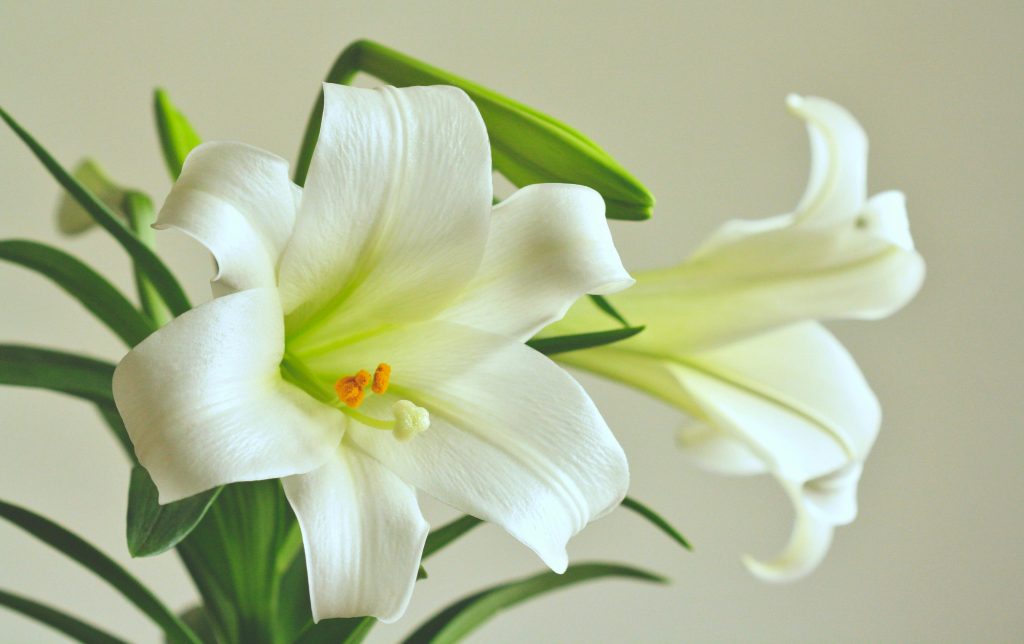
natural room fragrance, essential oil diffuser, a sample of herbs or flowers from the garden for smell, fragrant hand cream or oil for both smell and touch.
1] TASTE Finding a comfortable position, using your food item, placing this in your mouth without chewing, really taking the time to notice the textures as it is and how it changes just sitting there, very gently moving and chewing it as necessary with the most minimal effort.
2] SIGHT Really paying attention to what you can see through open eyes: colours, shapes, textures and anything else you can observe and take in through your eyes. Then, closing your eyes and being aware of any negative photographic imprint of what you have just seen. Subsequently, allowing this inner sight to take you to your sense of touch.
3] TOUCH Beginning to notice your touch points with floor and really focusing on body connections outside of the body, tuning into gravity, the weight of your body resting on the earth. Noticing how its feels at the lower points in relation to the front / top of the body. Noticing sensations of clothes covering the skin and sensations at the uncovered areas open to the air. Softness, warmth, coolness, textures of clothes or pockets of air. Being aware of your body’s position, the space it occupies and checking for balance between left and right side.
4] SMELL Reconnecting to the aroma of the oil or cream you used earlier, noticing any other smells, deodorant, perfume, cooking or even a memory of something from another time / childhood that has a positive association.
5] HEARING Being aware of your sense of hearing. Letting it move outside of the room to any sounds and resting on, or identifying, those sounds, if possible, then moving on to inside of the room, and awareness of sounds here, clocks, machinery etc. Then moving onto inside your body, watches ticking, the heartbeat other body sounds; if anything is to be noticed, simply noticing.
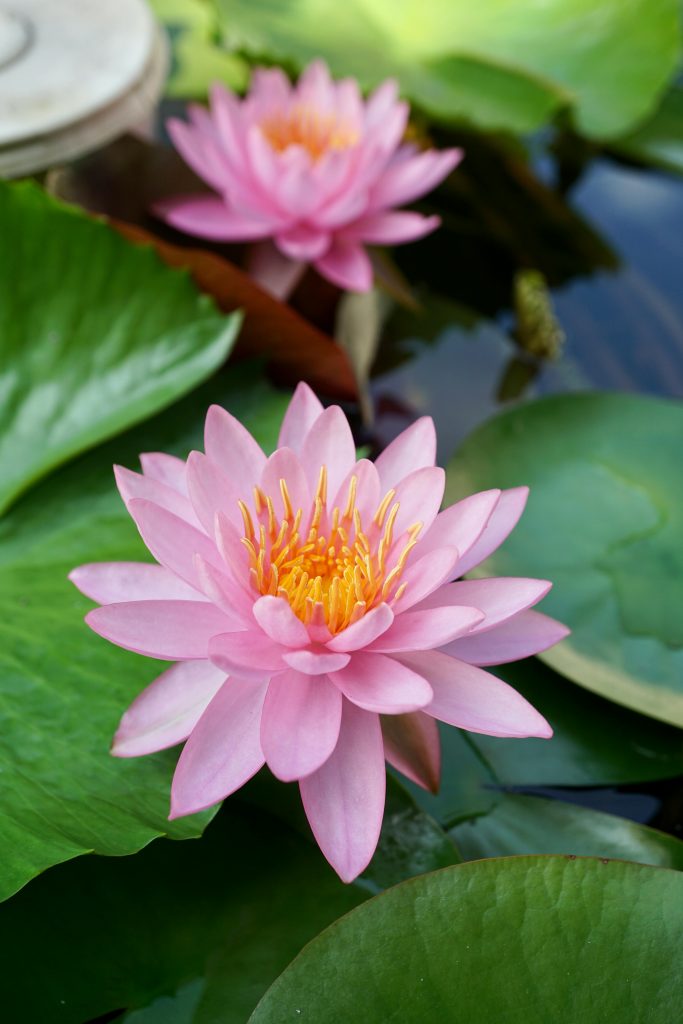
Taking the attention to your breath, being aware of movement at the nostrils and anywhere else movement may be occurring. Noticing the ebb and flow, change in any part of the breath, still points if they occur. Perhaps experiencing the breath as an inner touch point, moving body from the inside out as you inhale, and drawing from the outside back in on the exhale.
If you are intending any physical Asana practice in your session, bringing this in at this point. Keeping connected to the theme, slowing it down to really notice touch points, visually check hand and other body placement if you can see them. Really be present in the body, pause to observe the breath and where you can feel the inner touch points. Hear your body, and any sounds you can hear. If you usually play music in your practice, does it enhance or smother you connection?
I would suggest a mindful Sun Salutation or Balasana, Tabletop/Cat, Downward Dog flow of movement with pauses for transitions.

If you are not intending to do a physical practice or returning to reconnecting to all the senses at end of your session and, continuing with the breath focus, noticing the sound of your breath and tuning into the sound So on your INHALE and HAM/HUM on your Exhale. Following the sounds as the breath itself. SO HUM: I am that/that I am. Pausing all activity to just be as you are, having taken that journey like the lily flower to a place of light, peace, serenity and connection.
June 2025 Theme
June Yoga Flow by Nirmala Molloy

Embracing the Energy of Summer June is a time when the days grow longer, the sun shines brighter, and nature comes alive. This short yoga practice invites you to connect with the vibrant energy of early summer, focusing on themes of renewal, warmth, and grounding.
Begin in a comfortable seated position. Close your eyes and take a few deep breaths, inhaling through the nose and exhaling through the mouth. – Reflect on the essence of June: growth, abundance, and the beauty of nature. Set an intention for your practice today—perhaps a word like “abundance,” “radiance,” or “balance.”
Cat-Cow Pose (Marjaryasana-Bitilasana): – Flow through 5 rounds, bringing awareness to your spine and breathing deeply, feeling the warmth enter your body. – Child’s Pose (Balasana) – Rest in Child’s Pose for a minute, allowing your body to soften and relax as you breathe deeply into your back.
Sun Salutations – Perform 3-5 rounds of Surya Namaskar A (Sun Salutation A) to warm up the body and build energy Focus on linking breath with movement, feeling the sun’s warmth envelop you as you flow.
Grounding Poses (Virabhadrasana I): – Hold for 5 breaths on each side, feeling strong and grounded. Visualize yourself standing tall like a mountain, deeply rooted yet reaching for the sky.
Tree Pose (Vrksasana – Balance in Tree Pose for 5 breaths on each side. Connect with the stability of the earth beneath you and the openness of the sky above.
Closing Poses – Seated Forward Bend (Paschimottanasana): – Sit with your legs extended and fold forward, allowing your shoulders to deeply release tension.
Savasana (Corpse Pose) – Lie back, surrendering to the earth beneath you. Spend 5 minutes in stillness, focusing on your breath and integrating the energy you cultivated during your practice.
Gently begin to awaken your body, bringing small movements to your fingers and toes. When you’re ready, roll to your side and press yourself up to a seated position. – Conclude your practice by bringing your hands to heart centre. Bow your head slightly and dedicate the warmth and energy from your practice to yourself and those around you. Open your eyes, embracing the joy and vitality of June. Feel free to modify the flow to suit your level and enjoy the uplifting energy of the summer month!
Namaste
nirmala molloy
May 2025 Theme
By Judith Lynch
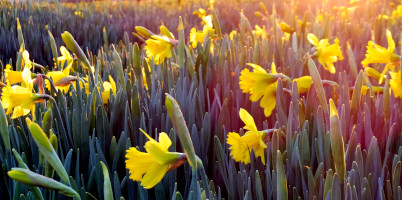
As we move through the month of May we find ourselves at the very heart of Springtime. With the early onset of warm weather in April this year many plants and blossoms flowered earlier than usual but the full opening up of most trees, shrubs, flowers and fruit bushes will come to a crescendo in May, bringing nature’s full beauty into our lives for us to admire and enjoy. So perhaps it is apt to focus on opening up our own hearts at this time of year. A time to focus on enjoying building our strength and vitality, releasing any stagnant energies. Then allowing joy, love and compassion into our lives
Perhaps start with seated centring, hands in prayer mudra becoming aware of your heart space. Continue on to practice lotus mudra which is said to calm the mind and tune us into the natural beauty of our soul. It can open up our heart chakra, connecting us to compassion and flow.
Possibly move on to butterfly pose lifting the heart, then folding forward.

Maybe then practise your best tadasana, standing in good spinal alignment but with feet hip-width apart. Lift the sternum, open the heart, lift the spirits. Then practise a few rounds of the Breath of Joy. This uses three full breaths. Firstly take a slow breath raising arms in front of you to shoulder height, as if you are drawing the energy of the earth into your body, then breathe out. On your second breath stretch arms firmly out to your sides and finally using a third breath raise arms above your head. Breathe out “ha” softening your knees as you fold forward, sweeping arms up behind you. Repeat the sequence then pause and rest feeling your energy move and settle. Raising arms in time with your breath is centring but it also brings strength to your arms, shoulders and upper back. The ”ha” breath out allows release of any tension or tightness.
Other warm-ups could be light hearted and fun.
“Be a lamb” From all 4s practise initial stage of Superhero balance simply placing fingers of one hand down in front with arm stretched forward and toes of opposite leg down with leg stretched behind. Change sides. Make sure your back is flat and your upper back lengthened, gaze towards the floor.
“Be a chicken” Place hands under armpits moving elbows back and forth and flapping your wings to encourage squeezing of the shoulder blades.
Other heart-opening asanas you might enjoy practising this month could be as follows. Remember to feel grounded as you inhale and then on each out breath feel a sense of freedom and joy in your movements.
- Warrior 1
- A flow sequence moving from downward dog to low lunge with chest opening and maybe raising your arms. Possible add-ons could be high lunge followed by warrior 111 and chair pose.
- Another heart-opening posture and balance to practise might be the dancer pose, making sure you keep your head up and chest open as you move into the final part of the asana. Let your heart sing!
- Suitable lying postures could be bow pose then seated relaxation, with upper body folding over bent up knees and head hanging, releasing back of neck.
- Maybe concluding with Bridge and Happy baby pose.
You could round off your practice returning briefly to the seated prayer and/or lotus mudra posture.
Or maybe come into a simple savasana, following your breath, allowing yourself to soften muscles and joints and sink into the ground, thoroughly enjoying your rest and relaxation.
A meditation practice which fits in well here might be The Metta Bhavana. This practice focuses on the development of universal loving kindness or emotional positivity. Thich Nhat Hanh, the famous Vietnamese Buddhist monk, created an excellent version of it but there are many around to choose from. I like to start and also finish with a focus on a sense of compassion for oneself, bringing the meditation “exercise” full circle back to one’s own heart space. Possibly with hands over heart or a big hug for oneself before re-energising.
April 2025 Theme
An Incoming Tide
By Kathryn Smith
As Spring progresses, it reminds us of the flowing tide of the sea. The tide is flowing into our lives filling us with new opportunities, new affirmations and new challenges. In order that we can open up to all of this, we must surrender to the sea, to the incoming tide of our lives. We are to be washed afresh, blessed by the seas gentle touch and cool caress.
The incoming tide offers us a chance to change, a time to be refreshed after feeling the stark bareness of Winter. Our Yoga practice can reflect these things as we move with greater ease in the gradually increasing warmth of the season.
You may wish to listen to the sound of the sea as you practice, to feel your incoming tide awakening you within.
1. Begin in Swastikasana, Virasana or another comfortable seated position where your spine is lifted. Take a few moments here to breathe. Bringing your attention to your breath, notice each inhale and exhale and how the breath mirrors the sound of the sea. Breathing in your fresh tide as the waves come close; breathing out and releasing any concerns or tensions to be washed away in the waves.
2. Moving into Adho Mukha Savasana to feel the earth at the four points of contact. Bending the knees to push the hips up to the Sun. Inhaling as you lift the knees up into the thighs and exhaling as you release the calves and heels down. Breathing here for a few breaths; feeling how you are connected to the earth whilst rising up to the warm sunshine. Exhale to come out of the pose.
3. Coming to Tadasana. Moving into Virabhadrasana One. Feeling the chest open, the arms stretching from the side ribs and the bend of the right knee as you release to the ground beneath you. Feel the breath alter as the arms are lifted.
Repeat with left leg leading.
4. Coming to sit on the mat. Move into Ardha Matsyendrasana with the right leg bent up. Feel the stretching and squeezing of the internal organs as you release the blood flow, opening up your internal tide. Hold the twist whilst breathing normally for a few breaths. Release slowly with an exhale.
Repeat with the left leg bending.
5. Come to Savasana or another position where you can be still and comfortable for relaxation, making sure you will be warm.
Return to your breathing, like the sound of the sea.
Relaxation – Incoming Tide
Relaxation- Incoming Tide
You are by the sea. The day is warm and sunny and as the sea rolls in you can feel the vibrations of its energy beneath where you sit. The sea rolls towards you and you feel a salty splash on your face. The tide moves out, ebbing away. The sea is loud and full of movement. Its endless restlessness, yet with such a restful influence on you. How strange that something so noisy and full of forceful movement should stir up so much peace. You stare at the foamy patterns in the water as the sea begins to swirl around your feet and you feel almost hypnotised. Breathe in the fresh clean air as the sea becomes a part of you. Watch the sunlight shimmering like tiny diamonds upon the waves. Feel yourself here, just you and the sea reaching out to touch you. Your nervous system soothed by its gentle caress…
Bring your awareness back to your breath. With two exhales bring your hands onto your body. Feel the movement of your breath beneath your hands like the waves of the sea…
Namaste.
March 2025 Theme: Spring Equinox
By Sue Hargreaves CYTA General Secretary
Spring Equinox
By Sue Hargreaves CYTA General Secretary
Spring is like nature’s ‘New Year’ , as the world appears to come to life again. A season of new beginnings and a time to start cultivating a change in your habits and outlooks, especially if you felt you pushed your way through winter , leaving you burnt out. Use this surrounding energy of growth, to grow mentally & spiritually towards a brighter and lighter way of being.
Consider adding the following to your morning practice:
- Balasana (Pose of the Child) flowing into Urdhva Mukha Svanasana ( Upward Facing Dog) and back again to reflect the awakening of Spring
- Upward Facing Dog with leg lifts to reflect the exuberance of Spring
- A balancing pose Virabhadrasana ( Warrior 3 ) reflects the balance of day and night at the Equinox .
- Utkatasana (Chair Pose ) keeps us grounded as the energy grows.
Visualisation on the change into Spring :
Take up your own comfortable relaxing position and be aware of your body and the space it is taking up on the floor.
Feel the earth beneath you and draw a cord from the base Chakra into the earth, imagining it going down through the various layers to the core and centre . Feel the cord being earthed , anchored. Imagine how this earth evolved. Yet the seasons come and go, the sea moves tidally and nature moves in her own direction and we are all dependant upon change.
Imagine the season of winter with its cold winds and frosts, the air crisp and the earth cold and hard . All is quiet and still. The days are long and dark . Animals hibernate, the earth seems to sleep, and yet bulbs are growing and roots searching. Then the first green shoots of a snowdrop pushes itself upwards towards the light.
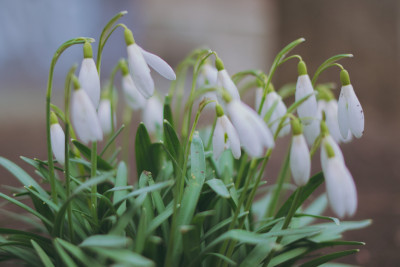
The pure white snowdrops are the welcome sign of growth and renewal, part of life’s natural cycle.
As the ground warms the snowdrops lose their purity and daffodils appear to herald the spring . The days lighten , the earth prepares for growth, and all around new life is forming. Spring flowers appear and bring the message of renewal, of hope, of life force and help us understand the cycle of nature.
This is the time when we long to be released from the dark winter days and crave the sunshine.
This is the time when nature is busy with the birds nest building, frogs mating, blossom forming, and we feel a sense of expectation.
Every season has wonder, and as nature begins her cycle , we know that transformation is change and in that change is balance.
Enjoy this time of year as we progress fully into Spring and its uplifting nature.
Enjoy this time of year to move forward and onto new pathways as your energy increases.
On Shanti
Sue
February 2025 Theme
by Jackie Hudson CYTA Committee Member

As the winter ebbs towards its completion and the first signs of spring start to appear I am enjoying times of reflection and a conscious awareness of my surroundings and the subtle changes that are occurring. Taking time to appreciate and reflect on our environment is important at this time of year as during the winter months we can become disconnected with nature and the outside world, perhaps becoming insular during the dark and colder months.
February brings two celebrations that can give us inspiration – Imbolc (or Brigid’s Day) and Valentine’s Day.
The Imbolc falls on 1st or 2nd February and is a festival of returning light and the stirrings of Spring. It is a turning point as spring starts to show early signs of growth and new life and it is the mid-point between the winter solstice and the spring equinox, or Cross Quarter Day.
The gaelic term Imbolc means ‘in the belly’ and is mentioned as early as 10th century literature, often relating to the new lambs beginning to grow in the sheep’s bellies. In yoga, belly breathing (or diaphragmatic breathing) has many benefits and is an invitation to create more space within the breath and perhaps gentle focus on the turning points (or kumbhakas) in pranayama.
Most people are aware of February 14th… this can be a good way focus on the heart space and cultivate feelings of love and compassion. Partner yoga can be a nice way to celebrate Valentine’s if that is appropriate for your group or if not there are many ‘heart opening’ asanas that we can practise:
Bow, Bridge, Dancer, Cow Face, Cobra, Camel, Fish, Sphinx…you get the idea.
Finally, a great way to connect to the heart space is through a gratitude practise. Some people find a gratitude journal helpful and for others simply to look around you the next time you are ‘present’ and count 5 or 10 things you are thankful for – simple things or more complex (eg, your ability to actually see, the cup that might be holding your cup of tea, the sense of taste to be able to enjoy the tea). Gratefulness is way to become more present in our daily lives and can lift our mood and enhance our physical health and done on a regular basis as part of your yoga really helps us to connect with our heart energy.
Sending love and light
Jackie
January 2024 Theme
by Diana Davidson Vice Chair of CYTA
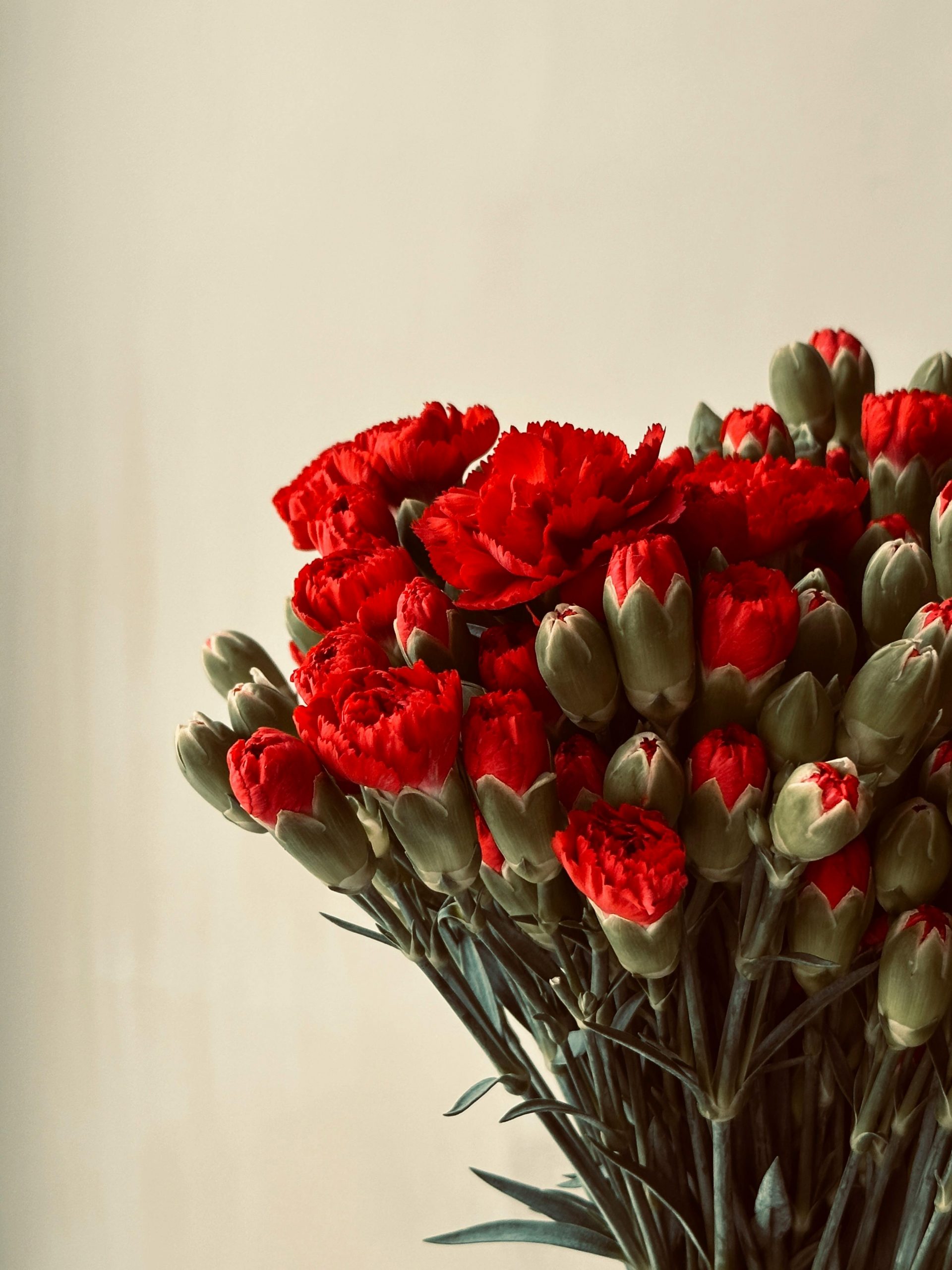
January the first month of the year was named after the Roman god Janus, often depicted with two faces – one looking back to the past and the other pointing to the future.
This is the season of resolutions and we need to look back at our failures and successes of the past year as we reflect on what we need to do to either maintain or change the progress of our lives. Resolutions are usually hard to make and then keep.
There is a story from Japanese folklore – I don’t know where I first heard this but it rings very true to me.
There was once a mystical bird who sat dreaming in the sun all day whilst the other birds were busy making their nests. When night came the busy birds were warm and cosy in their nests but the day dreamer was cold and hungry. In the morning he resolved to make his nest but – you’ve guessed it! He again sat on his branch and continued to daydream…….
Its OK to live in the present mindful moment but also we need to get real and take responsibility for our lives.
As a former relationship councillor and therapist I was able to encourage people to make significant changes by asking them
‘ Do you really want to change? ‘What would be the outcome?’
If you do want change – is it REALISTIC? – De clutter/practice your yoga more/be more understanding of people with problems of race/disability. Take better charge of your finances? – its for you to chose what is right for you.
Take it in small steps so that your goal/resolution is ACHIEVABLE – ask friends and family for help. Be positive.
Of course you need to be very honest with yourself and this is where Patanjali’s teaching of the Eightfold Path come into their own as they set up a structure of thought, behaviour and action. ie Tapas -Self Discipline Satya – truthfulness Ahimsa- do no harm-non violence – mentally/physically to self or others. Aparigraha – Don’t be greedy –hording- holding onto ‘stuff’
But above all, I think that we all seek contentment – Santosha, making and keeping resolutions go a long way to achieving this state of mind.
The flower emblem for January is the carnation and the gem stone is a garnet, both are red and this is also the colour of our base/root chakra Muladhara. The postures most associated with Muladhara are situated at the base of the spine/pelvis. These if practised regularly will keep us grounded and in balance.
Red in all its various hues is said to be very energising so maybe you might like to have some red around you when you practise or just in your everyday life-I always feel better and more alive when I am wearing red- even if it is only a touch of ‘lippy’
Asanas for Maludha Chakra
Tadasana (tree) Set resolve, use ujjai breath for strength
Padottanasana Standing forward bend
Trikonasana
Any of the Warrior poses – what does your body need today?
Finish with Maltese Cross, reflect on what you have achieved- is there need of change in action or attitude?
Meditation or Relaxation -your choice
I wish you all Santosha for 2025
Diana
December 2024 Theme
by Sue Hargreaves General Secretary of CYTA
Tonight we use TRATAKA , concentrated gazing, so you will require a large lit candle .
Sit in your meditation pose, with yourself upright & comfortable. Hands can be in a Mudra or in your lap. The room should be dark and keep yourself warm.
Time your TRATAKA to suit yourself (between the times of 7 and 9pm if possible).
Give yourself 10 minutes.
Tune into your breathing,being aware of the inhalation, the pause, the exhalation and the still point. As you feel the breath slowing, feel the release in the body- the shoulders without slumping, the hands & face, especially the jaw relaxing. Be aware of the movement of the body- the abdomen, chest and shoulders, allowing a feeling of openness in the chest as the shoulders widen and sink.
Close your eyes and look into the eyebrow centre, Ajna Chakra.
Then open your eyes and gaze directly into the candle flame between lowered lids. Observe the size of the flame, how it lengthens & shortens, the flicker, the shape , how it changes.
Now look at the colour , the aura around the flame, the wick, the haze of light surrounding the whole candle.
Now close your eyes and look into the eyebrow centre and try to recapture the image.
If it draws away, try to bring the image back to the centre.
Open your eyes again and repeat the exercise noting if there is a change in the brightness of the light, more than one aura, a different shape or colour of the flame . Observe and release.
Close your eyes and again rest in the centre of the forehead.
Repeat once more.
Let the eyes totally relax . Check the body is still relaxed.
The candle is light . The flame can illuminate the room and if this is all you had it would be the difference between light and dark, between fear and security. Bringing comfort and reassurance .
In this troubled world many people have only a candle flame.
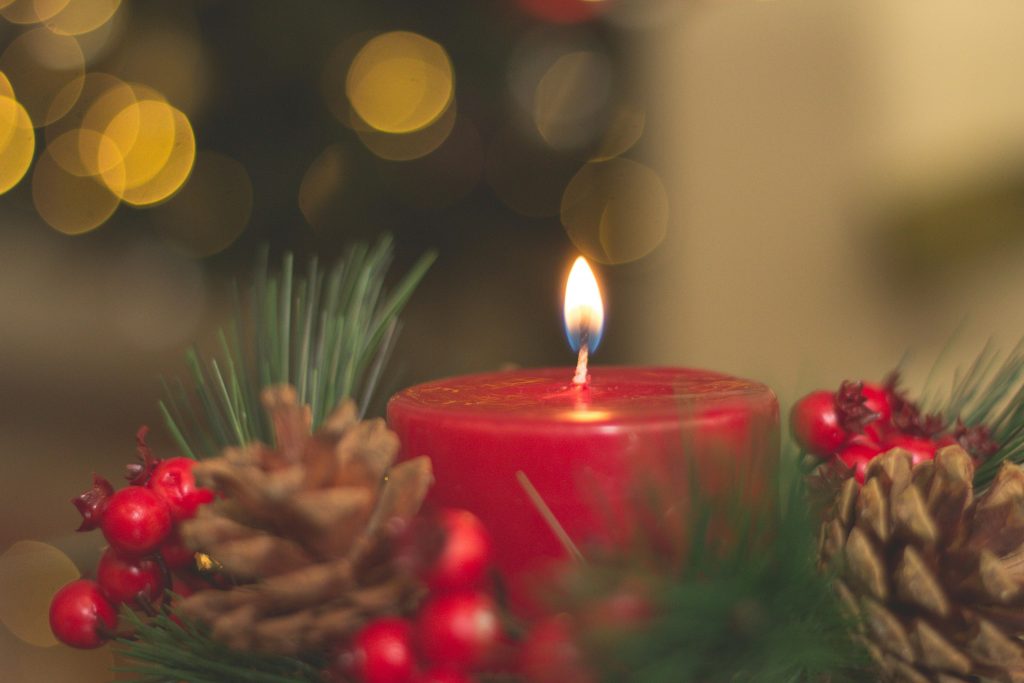
Love and Light to you at this special time of year.
Sue
November 2024 Theme
CYTA Autumn Theme
By Mary Garvey
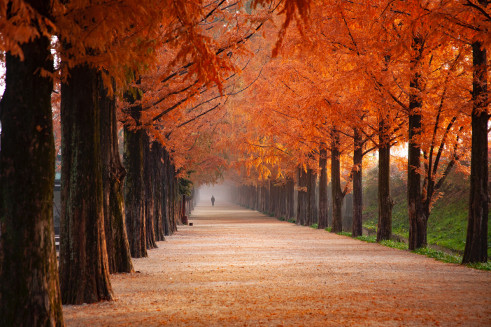
November is an interesting month. It feels like we are on the cusp of change. I must admit as November looms I’ve often found myself experiencing a sense of dread for what was coming down the line. The Summer has gone along with the growth and colour in our gardens, even the most resilient of plants are starting to fade away. There is less light, more darkness. The winter and inclement weather is looming, and even the Autumn is slipping away.
By now the clocks have changes and “fallen back”, so in a way there has been a change in time! In terms of recording of time, it is interesting to consider the word November comes from the word novem, meaning nine. November was originally the ninth month of the Roman Calendar. Somehow the name has stuck but on the eleventh month instead, so if you’ve ever felt a sense of imbalance around this time of year, perhaps this explains it.
November is officially a time of remembrance for those who have contributed in two World Wars and later conflicts and the anniversary of the end of hostilities in World War 1, and many of us will wear a poppy to remember those who served. It often feels like November itself mirrors the sombreness and contemplation of the occasion. We have Halloween and Bonfire night as milestones as the month proceeds on its journey through time.

Exploring November from a different perspective can perhaps bring a little lightness into our experience of this month as we approach the darker time of the year. I wonder if the darkness is something to be fearful of, or instead, can we embrace the consideration of being in harmony with the natural world. Our ancestors celebrated the festival of Samhain or Summers end at this time of year. It was also considered the end of harvest time and approach of a New Year. In Irish/Gaelic the word for November is Mi na Samhna, the month of Samhain. It was believed that at this time of year the boundary between the living and the dead was at its thinnest, and a lot of what we perceive as Halloween traditions stem from this time. Examples include the tradition of dressing up and wearing masks, leaving treats out for any friendly spirits or trick or treaters. Traditionally it was a time for lighting bonfires to combat the impending darkness, building altars to honour ancestors and symbolising the end of harvest, coming together, dancing, feasting and carving faces into turnips to make lanterns to ward off evil spirits.
Perhaps we can embrace this month as a time for introspection, a chance set our intentions once more. November may be an opportunity to consider what weight we can release, the things we can let go of, as the last leaves fall from the trees, so we can move forward perhaps feeling a little bit lighter for doing so. Mirroring nature during this season of introspection allows us to have a time when we can let go. Remembering the warmer and brighter days with gratitude and those we miss. This is a chance to have our time to hibernate, to embrace the darkness and its positive attributes, giving us a chance to reflect. In the more dormant state of the weeks ahead nurturing the space for all that is positive within us to germinate and be ready to reach our full potential when the Spring /light returns.
In these days of November consider investing in these quieter, darker days by participating in some nurturing practices. Perhaps making you own November altar with some leaves, a candle, photographs and anything you are drawn to, spending time putting it together. Lighting you candle and considering you intentions. Enjoying the impact the illuminating effect that a single candle can have. Listening to our bodies and physically taking care of ourselves, revelling in a state of rest when we can. Enjoying the company of others when we get the opportunity. Taking time to be outside, to walk and to move, when we can, really noticing the changing face of nature and particularly paying attention to the trees, who appear to be in a state of suspension knowing it is all part of the self-regulating cycle of growth, abundance, decline and decay.
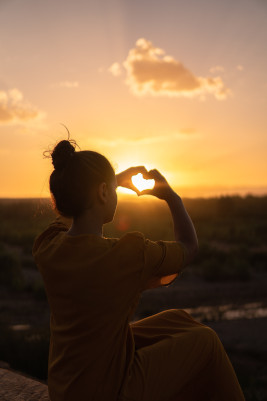
Suggest practice, walking warrior 1/Virabhradasana 1
Begin by lighting a candle and stand in Tadasana and tuning in.
Taking the right foot forward and back/behind, at first noticing the foot moving and then noticing footprint change/movement and response of feet heel to toe type movement.
Gently sweeping arms forward palms up as foot moves forward and back, palms down and arms gently back as the foot moves back, so it feels gently dynamic.
The left foot stays on the spot its on and responds to opposite side foot/leg movements.
Leave the right foot back/behind and moving to adopt it to Virabhradasana 1.
Tuning into the posture and pausing.
Repeating on the opposing side.
Finishing with Vrksasana, with a nurturing Anjali Mudra held at the heart.
Tadasana
October 2024 Theme
Celebrating Durga Puja: Honouring the Invincible Goddess Durga
By David Glover

When it comes to the month of October, for most people it’s about withdrawing, getting cosy
indoors and starting to think about eating warm unctuous stews to keep out the cold. But not
for me, my preference in the run up to October is to summon the spirit of the invincible
Goddess Durga. This involves jumping on the back of a lion, with a trident in one hand and
various instruments in the other seven to summon the qualities of strength, wisdom and
protection. Metaphorically speaking, of course.
Who is Durga?
The deities in the Hindu pantheon are imbued with symbolism and point towards
characteristics or particular energies which individuals can draw upon in times of need. This
can be done through mantra japa and allowing the vibrational energies to do their work.
One such deity is Durga who embodies Divine Feminine Energy. Durga’s creation is rooted
in a powerful mythological story that highlights the need for collective strength in the face of
darkness. According to Hindu mythology, a demon named Mahishasura became so powerful
that neither gods nor humans could defeat him. His strength threatened the balance of the
universe, and even the mighty gods—Brahma, Vishnu, and Shiva—were powerless to stop
him. Now this isn’t a blame game, but it was Shiva who granted the demon with immortality.
These days it would be called an administrative error.
Anyhow, in response, Brahma, Vishnu, and Shiva combined their energies to create Goddess
Durga, a warrior goddess unlike any other. Durga was the embodiment of divine feminine
power, formed to be invincible. She was bestowed with the most potent weapons from each
god, symbolizing her role as the ultimate protector of the universe. Mounted on a lion, Durga
represented an unshakeable force of strength, courage, and compassion.
Thus, Durga was created to restore cosmic balance and eliminate Mahishasura’s tyranny. Her
creation is a reminder that feminine power, when harnessed, has the potential to overcome
even the most formidable adversaries. As the Dad of three daughters, this makes perfect sense
to me.
One of Durga’s most distinctive features is her multiple arms, typically ranging from eight to
ten in various depictions. Each arm holds a symbolic weapon or object, representing the
virtues and strengths Durga embodies.
- Trident (Trishul) – Gifted by Shiva, the trident represents the destruction of evil and
the power to eliminate ego and negativity. It symbolizes balance among creation,
preservation, and destruction. - Discus (Sudarshana Chakra) – Vishnu’s disc represents Durga’s control over time
and space, symbolizing righteousness and the ability to maintain cosmic order. - Conch (Shankha) – Also from Vishnu, the conch signifies the primordial sound of
creation. Its vibration destroys ignorance and brings spiritual awakening. - Bow and Arrow – These weapons represent focus and precision, symbolizing
Durga’s ability to balance potential and kinetic energies. - Sword (Khadga) – A gift from Ganesha, the sword symbolizes wisdom and the
power to cut through falsehood and illusion. - Lotus (Padma) – The lotus represents purity and detachment. Like the flower that
rises above muddy waters, it symbolizes spiritual growth and resilience. - Thunderbolt (Vajra) – Gifted by Indra, the thunderbolt stands for determination
and unshakable resolve in the face of challenges. - Mace (Gada) – A symbol of strength and courage, the mace, often associated with
Hanuman, shows Durga’s readiness to face obstacles.
Each item in Durga’s hands embodies a key quality that we can invoke in our own lives. The
conch for spiritual awakening, the sword for clarity of mind, and the trident for overcoming
negative energies—Durga provides us with the tools to confront and conquer life’s
challenges.
Durga’s Battle Against Mahishasura: The Triumph of Good
Durga’s epic battle with Mahishasura lasted for nine days and nights, Durga fought
Mahishasura, who changed his form several times—transforming into a buffalo, a lion, and
finally a human—using his shape-shifting abilities to elude defeat. Durga, however, remained
steadfast and unyielding in her strength.
On the tenth day, Durga ultimately pierced Mahishasura with her trident, signifying the
victory of good over evil. This day is celebrated as Dussehra in many parts of India, marking
the culmination of Navratri and the goddess’s triumph over the forces of darkness.
Chanting “Om Dum Durgayai Namaha”: Invoking Durga’s Power
The mantra “Om Dum Durgayai Namaha” is one of the most powerful ways to invoke the
goddess’s qualities. “Dum” represents Durga’s protective and empowering energy, and
through chanting this mantra, devotees call upon her strength, wisdom, and protection. The
mantra reminds us that, like Durga, we have the inner power to conquer our own struggles,
whether they are external challenges or inner fears.
How I came to this practice
My own practice in the run up to October has been to chant the mantra 108 times most, but
not all, mornings if I’m being honest. And I find it does make a difference.
Through the mantra “Om Dum Durgayai Namaha,” we connect with the divine feminine
energy that resides within each of us, empowering us to face life’s challenges with grace and
fearlessness.
And here’s another thing, I’m not sure why I started to chant the mantra but I just did and it
felt right. And when I started to dig a bit deeper it turns out that Durga Puja, a celebration of
divine feminine strength takes place between the 9 th and 13 th October in certain parts of India.
My advice to you…give it a go and if it feels right, keep going.
Om Shanti, Shanti, Shanti.
David
Photo credit:
Photo by Subhajit Biswas: https://www.pexels.com/photo/figure-of-hindu-goddess-durga-
18971794/
September 2024 Theme
By Anne Bailey

September is the 9th month of the year and the first month of Autumn. September is also National Yoga Month and a great time to celebrate the many benefits of a regular practice. We could use September as a month for Svadhyaya (self-study – the 4th Niyama) when we reflect on our personal yoga practice. We all come to yoga for our own reasons. As for me, I had a lot of pain in my lower back and had heard that yoga could help. With an amazing teacher and a regular gentle practice, my back muscles gradually improved. I only occasionally get the odd twinge in my back now – usually when I’ve been overdoing things in the garden. When my back pain returns, I know the yoga poses that work for me and I’m soon on the road to recovery. There are so many benefits to yoga for the body, mind and spirit and September could be the month when we pause to consider what attracted us to yoga and which benefits are most important to us. During this time, we could read up on an area of yoga that interests us, or we could try a different class and style of yoga. Or maybe we could encourage a friend to come along to our regular class so that they can enjoy the benefits of yoga too.
When practicing yoga, we can try to move more mindfully into and out of postures – even in the very familiar poses. We can tune into how our body feels before and after the practice. During practice we can notice any tendency to over exert ourself and back off. Also, we can notice the quality of our breath in each pose. If we’ve gone too deeply into a pose our breath can get choppy, so we need to come to rest until our breath becomes smooth and steady again. We could see if we can set aside 5 minutes a day for a short meditation and notice the benefits that this brings. We could get a book from the library to learn more about a meditation, mudras or chakras.
During September, we could practice the breathing mantra meditation ‘Soham’. Starting with a duration that fits into our lifestyle and if we find it to be a helpful practice, we can gently and gradually build up our time with it.
Soham meditation: Sit in your favourite supported position, with the spine upright but relaxed and an open heart. Begin by allowing your breath to settle, then notice the in-breath and the out-breath. Your hands can rest on your lap or you can use Dhyani Mudra – placing both hands in your lap with the left hand inside the right hand and thumbs lightly touching each other like a bowl. Notice the sensations in the nostrils – the movement of the breath and its temperature. When your mind wanders, gently guide your attention back to your breath. After about two minutes of noticing the sensation of the breath in the nostrils you can begin to link your breath to the mantra Soham. With a slow, deep inhale think of the sound ‘so’. Then exhaling slowly, think of the sound ‘hum’. Continue this steady breathing silently saying ‘so’ as you breath in and ‘hum as you breath out. Soham means ‘I am’. This practice aims to help to calm the mind whilst connecting to a sense of inner awareness – knowledge of the self. Continue to practice for a further 3 or 5 minutes, then gently let the breath awareness and mantra go and return to your natural breath. After siting quietly for a short while transition back into your day.
Have fun – enjoy your practice.
References:
Deepak Chopra & David Simon (2004), The Seven Spiritual Laws of Yoga, John Wiley & Sons Inc
Rolf Sovik Understanding Yourself: The Path of Svadhyaya (yogainternational.com) [Accessed online 31.07.24]
Image: pexels-elly-fairytale-3822164 provided free to use by pexels.com
August 2024 Theme
‘Stop and Smell the Roses’ – A Gratitude Practice
By Nirmala Molloy
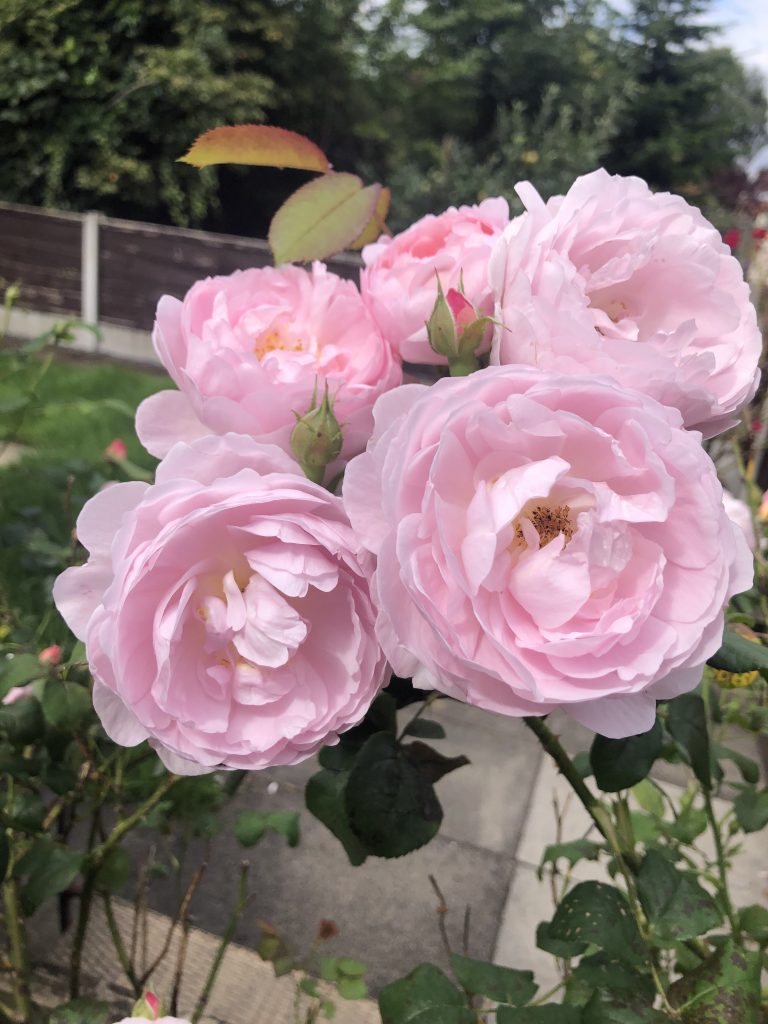
August has arrived and it feels like we are still in the full throws of summer. Gardens
bursting with colour and hedgerows full of fat juicy blackberries. August is bound by
abundance and what has been given to us freely by nature and mother earth.
August brings us past the half year mark and yet it is still full of activity, excitement, and
holidays. What a good time to be able to stop and take time to become grateful for all that
has passed and all that is yet to come. Taking a moment to ‘stop and smell the roses’ is a
saying which we are all familiar with, but how many of us actually take the time to stop,
even for a moment? 24 th June saw the rising of the Rose Moon, a beautiful pink of glowing
wonder. Roeses have their own way of speaking to the heart. The David Austin Clair Rose
which was grown from a bare root is my favourite. With its milky pink folds and rich aroma
it sends me into a world of dreams and possibilities.
A gratitude practice whilst holding a beautiful rose in our hand(s), can expand our
awareness and still the mind. It’s a practice that will ground us in the here and now and
enable the busy mind to quieten as we become fully present in the moment using our
senses.
Gratitude Practice Using the Senses
Find a suitable place in the garden or any outdoor/open space and sit in ‘your’ upright
seated position. Take a few moments to become completely comfortable and let your
entire body relax. Maintaining a tall spine, rest your hands comfortably in your lap.
Begin to tune into your breath, becoming aware of your physical body and as you breathe,
fill your lungs with a full breath and feel your lungs expand side to side and from top to
bottom. Exhale slowly and steadily until your lungs are totally empty. Repeat this a few
times. Now let your breath become easy and steady again. Observe your feelings and
observe your thoughts and whatever comes up, simply allow it and let it flow away.
Now take a rose or even a single petal into your hand(s) and think of something you are
grateful for today or something you are grateful for in this very moment – and hold this
image in your mind. Breathe and let this image into your heart as you thank the universe for
this precious gift that has been bestowed upon you.
As you hold the rose, set your eyes on the beauty of the rose – the colour, the shape, the
size, the folds. How many petals can you count? Do you see the yellowy stigma and the
white filaments? Does your rose have small green leaves still attached to the stem? How
long is the stem? Let your eyes feast on this beauty whilst internalising this experience.
Next, take your awareness to the sense of touch. Use the tips of your fingers to brush
gently across the velvety petals. How does this feel for you? And the stem – run your finger
and thumb along the stem. Does the stem have thorns? How prickly they are!
Sitting in quiet stillness for a moment and perhaps closing your eyes, take the rose up to
your nose and take a long, steady inhale of its fragrance. What does this scent remind you
of? Where does it take you? Does it bring back pleasant memories of times past. Just bask
in the pleasant aroma of the moment and the soft pink of peace as you let the smell drift
into your heart and body.
If you want to, bring the rose to your lips, see how it feels, does it feel soft and satiny? You
may want to touch it gently with your tongue, examining the texture and the taste. Stay
here for as long as you want, there is no need to rush.
As you bring this practice to a close, sit in silence allowing the image of gratitude to reside
with you for the rest of the day.
Namaste
Nirmala
July 2024 Theme
Midsummer Reflections
By Judith Lynch

The month of July is midsummer. It is associated with both the energy of the fire element and the Manipura chakra. When these two are in good working order we digest our food well and absorb more nutrients into our body. We take in the sunlight which invigorates the body, bringing a glow to skin and eyes. The inner fire, or Agni, can also ignite our minds bringing ideas and understanding. The combination of the fire element and manipura can help us to gain confidence, determination and freedom to grow and to enjoy ourselves. Fire also opens our heart to giving and receiving love and compassion.
The energy gained from the fire element can help us to take action and be more focussed. Tapas, or discipline, in terms of yoga could be applied to establishing a regular yoga practice routine. It is good to start small and then build up consistently from there. Or perhaps this month you could choose to apply the tapas principle to improving your diet or your meditation practice or simply observe when you are impatient and practise being helpful, kind and calm. Using our energy productively is key. Are we spending too much time worrying?
Centring/warm up for a yoga session could include waking up the solar plexus/manipura chakra by patting the stomach, circling palm on palm around the navel and then rubbing the lumbar area of the back.
The obvious yoga asana practice for July is Suryar Namaskar. Salute to the sun awakens the energy centres along the spine increasing heat with each cycle. It can of course be practised in a more meditative way reflecting on the earth beneath us and the sky and sun above and on our connection to everything else as well as the effects of each posture within the cycle.
“The sun is Prana, the life of this universe , and he rises the life in giving joy to human eyes”
Prasna Upanishad
Other strong and centred yoga postures connect us to our energy flow and inner glow. Strong standing asanas such as Warrior poses, Chair Pose or Parsvakonasana bring heat to the big leg muscles and spread it to the rest of the body. Holding in these shapes for a number of breaths can build strength and stamina. Stimulating back bends can invigorate you and tap in to heat and energy if you are feeling a bit lethargic. Dancers pose perhaps particularly so. To balance manipura and support the power at the centre of our being we need to practise asanas which support core strength. As well as abdominal muscles think pelvic floor, the back and side waist muscles and also the hip flexors. Various versions of the boat posture, head to knee postures, tadasana or versions of tree balance might fit the bill. Last, but by no means least, practise twists to massage and squeeze the digestive organs, increase the flow of energy in the manipura chakra and fan the flames of digestion.
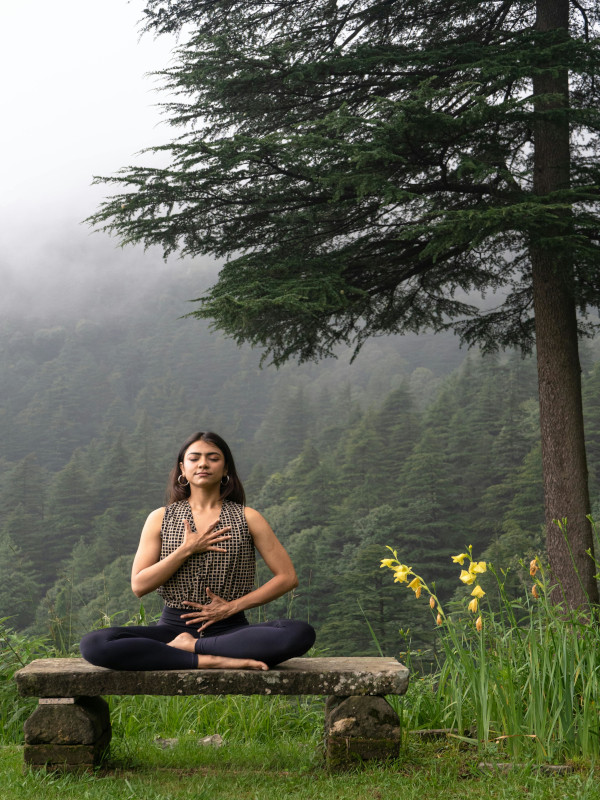
Breathing recommended for this time of year includes utilising the Ujjayi breath and perhaps practising Kapalabhati breathing, sometimes called The Breath of Fire. Please check the contra- indications of this pranayama before practising.
With all this emphasis on energy flow and stronger postures it is however important to remember to keep a balance. Excess red fire energy and emotion can lead to over excitement or even heart palpitations in some people. We are often busy enjoying other activities in July and can become tired or even burnt out. So resting and relaxing between asanas and certainly at the end of your yoga session is crucial, particularly if the weather is very hot. You could meditate on the manipura chakra symbol, especially the red triangle in the middle to help balance the chakra. A restful relaxation could involve placing hands on the solar plexus, tuning into your breathing and feel the abdomen swell under your hands and then relax and soften towards the spine on each out breath.
Just remember :
“In every person there is a sun, just let them shine”
Socrates
Namaste
Judith Lynch
June 2024 Theme
Summer Reflections
by Lisa Hargreaves

June celebrates the summer solstice. Gifting us with the longest day of the year, a time of transformation and new beginnings, with the changing season. It’s a time of reflection and renewal or setting an intention.
Our yoga practice may embody this process by including practices that honour the sunshine whilst balancing summer’s pitta dosha. Moving mindfully through sun salutations, so each movement flows like the ebb and flow of the tides, feeling the meditative quality. The breath is equally flowing using ocean sounding Ujjiyi or cooling sitali during pranayama.
The summer sun’s fire element, associated with the solar plexus, provides the stimulant for digestion, ambition and willpower. These qualities may influence our meditation practice by visualising a transformational fire burning away tension, thoughts, and emotions no longer needed.
Including complimentary cooling Ayurvedic foods in our diet at this time, such as peaches, watermelon and dates may also provide further support.
In a tranquil village, Arjun, a wise old man and the local yoga guru, practiced yoga under a banyan tree each morning. One day, Priya, a young woman overwhelmed by the pressures of modern life, approached him for guidance. Despite her professional success, she felt unfulfilled and disconnected from herself.
“Master Arjun,” she sighed, “I’ve achieved much, but I feel empty. How can I find peace and meaning?”
Arjun smiled serenely, his eyes twinkling with mischief. “Well, let’s start with something simple. Can you touch your toes?”
Priya awkwardly attempted, wobbling slightly. “Um, not quite.”
“Perfect,” Arjun said. “Now you’re in the right mindset for enlightenment. Join me in a simple yoga pose.” They sat together, and he continued, “Life is like yoga. It’s about the journey and awareness in each moment. The Bhagavad Gita teaches us to perform our duties without attachment to outcomes, finding contentment in the present.”
He then shared a story: “A sage named Vyasa once took a restless prince to a river. Vyasa said, ‘Watch the river.’ The prince asked, ‘Why?’ Vyasa replied, ‘Because Netflix wasn’t invented yet.’ But seriously, ‘Life is like this river. When we flow with the current, accepting each moment, we find peace. Strive not for what you lack but embrace what you have.’”
As Priya practiced yoga and listened, she began to feel a sense of calm and clarity. She realised that constant striving had made her lose sight of the present moment’s beauty. Arjun’s teachings resonated deeply, reminding her that true fulfilment comes from within, not external achievements.
“Thank you, Master Arjun,” Priya said, feeling lighter. “I’ll start incorporating mindfulness and yoga into my daily routine.”
Arjun chuckled. “And remember, when life gets tough, just breathe. Unless you’re doing the downward dog and your neighbour’s dog starts licking your face—then you can laugh instead.”
“Live quietly in the moment and see the beauty of all before you.
The future will take care of itself.”
Paramahansa Yogananda
References:
Image 1 – LJ Hargreaves October 2023
May 2024 Theme
A Peaceful Practice
by Kathryn Smith
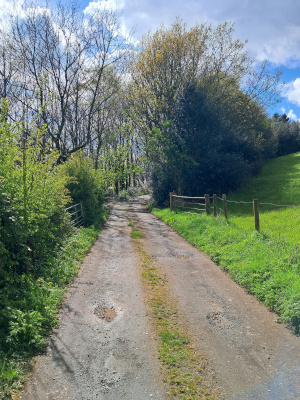
In the Celtic tradition, May marks the beginning of Summer. Although the saying “Never cast a clout until May is out” can be quite negative (a clout was a piece of clothing; thus suggesting that you keep your warm clothes on as the weather can still be cold) perhaps this is now the time for us to start to venture outdoors once more.

After the Spring rains which have watered the earth and the longer hours of daylight, nature has been kick-started once again. The birds are nesting, animals are giving birth and all around us shows the blossoming of life.
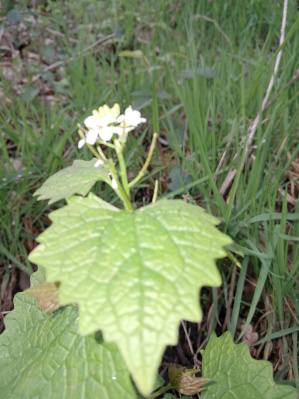
It is now time to find a quiet space outside where we can contemplate the dreams and plans which we made over the cold Winter months. Can we now be true to them, rather than slipping back into our old lazy ways?

Let us get out into an open space where we can practice our Yoga with the help of nature using the earth as our mat.

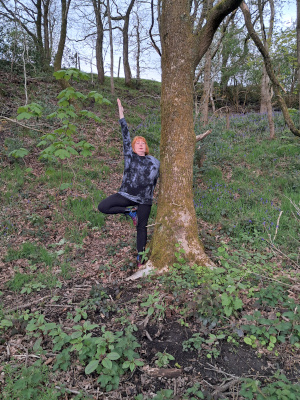
After your chosen practice you could sit down to meditate or to enjoy the following visualisation:
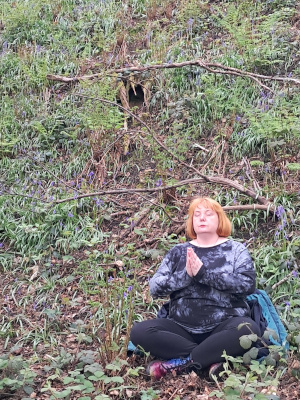
Interior
You are sitting high up at the edge of a cave looking out across the land and the sea. You are sitting cross-legged with your thumbs and forefingers touching in Chin mudra, soaking in the atmosphere.With your hands in this position you can feel the gentle rise and fall of your abdomen as you breathe correctly and easily. As you sit here you can feel the gentle breeze against your face and the air around your body feels like a soft enveloping mist.
You close your eyes and bring your awareness to the rhythm of your breath. The rise and fall of your abdomen, the air moving through your nostrils.
You feel the rocky outcrop below you, the vast open space before you and the sweet silence all around you. Feeling each breath as it comes and goes.
You are dressed in a comfortable robe which flows around you. Feel its softness against your skin as you breathe. Feel the comfort of the robe in this high place.
The sky is cloudless, its pale shade reflected in the sea below. From your elevated position you can see the land functioning and busy. In contrast, you are away from the tedium of the world, set apart and secluded.
You breathe from the earth where you sit feeling grounded; breathing up through your body this stability and stillness. Exhaling from the crown of your head up to the sky above feeling calm and quiet.
Feeling connected; the earth and your body.
The sea and the blood in your veins.
The rocks and your bones.
The wind and your breath.
Related to nature.
Your very existence from the essence of creation…
The lines between your body and this place begin to blur…and you find yourself comfortable and rested in a relaxed position.
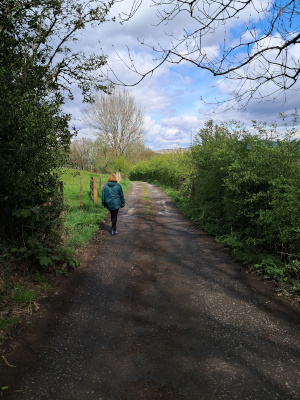
April 2024 Theme
by Sue Hargreaves, CYTA Committee Member
April seems to have arrived all at once . Spring is my favourite time of year and my thoughts go to renewal and new life. We will see this all around us in various ways, and each of us will find something that captures our focus. My focus came before April arrived, in March, awaiting the birth of my great granddaughter. A new life for our family, eagerly awaited.
This prompted something in my memory, of a former student, who taught yoga to children. Maybe it is something you do? Or wish to explore? Or just to teach your own children/ grandchildren/ great grand children ?
Here is a flavour of how she went about it.
Her ‘rules of practice’ were:-
- Nose for breathing, mouth for eating.
- Breathing for relaxation and quiet times, use top chest, middle chest, diagphragm
- Breathing during active times, in through the nose out through the mouth
- To do what suits them, rest when ready and don’t push yourself
Initially they were taught Vajrasana, Dandasana, Shavasana, Ardhasana, Tadasana.
She used a visual story to aid them to remember the order of the practice and to make it fun!
A suggestion is – going for a row in a boat to an island to enjoy the day and the attractions of the island.
Getting boat ready
- Dandasana
- shakti bandha no.3 ( pulling on rope) to put up the sail
- Triangle to unfurl the sail
- Boat balance, arms out as oars>open legs to see where going
- shakti bandha no.1 ( rowing the boat)
Out on the water- what can we see?
- Standing twist (using hands from brows) to see from the crows nest
- Shakti Bandha no.5 (the salute) to dive into the water (swimming is good, you CAN breathe underwater)
- Fish pose
- Turtle/ tortoise pose
Arrive on shore– rest in corpse for short time to get breath back. Funfair at top of hill beckons.
- Swings – balancing pose
- Helter Skelter- reverse plank
- Waltzer- seated dynamic twist
Back on shore
Sitting- watching the breath, sound around, withdrawing from them to concentrate on the breath
Relaxing in corpse using a warm visualisation.
My thanks for this inspiration go to Hania.
Something else to consider is a book I reviewed in June 2022 which is yoga for children . I wrote a full review of it, which you can view on our website in Resources, Book Reviews.
‘Once upon a time, you….’ by Maria Oliver Pub. Halldron Books ISBN 978-1-8383024-1-2
Have fun! Sue
March 2024 Theme
By Jackie Hudson, CYTA Committee Member
March is a time of change and new beginnings. The days are beginning to stretch out now so that we will come to the equinox (equal daylight and nighttime) on March 20th. It is a time of potential and new growth – a time to welcome in the sunshine and dust off the darkness of winter. (It’s also my birthday on March 19th!)
After teaching yoga for 15 years I find my themes become quite organic and classes tend to be a reflection of my own circumstances but also the wider world including seasonal changes. The funny thing is, a few students also attend other classes and it is commonplace for them to comment on the fact that their other teachers are practicing the same asanas, pranayama and themes.
At the moment we are enjoying going right back to basics with a beginner’s mind – building up each posture from the roots and focusing on alignment and rather than flows or sequences taking time to explore and deepen into the postures. March is traditionally a time to spring-clean and by cultivating a beginners mind in yoga it is as if we are wiping the slate clean and starting over. Shoshin is the zen Buddhist concept of beginner’s mind – fresh, open and free from habit. By maintaining a beginners mind we keep ourselves receptive to new experiences, techniques and perspectives which can help us breath through mental and physical barriers and deepen our yoga practice.
Looking forward to seeing some of you on the 16th at our Spring Workshop with Nick Edge and sending Spring Blessings x
February 2024 Theme
By Diana Davidson, Vice Chair of CYTA

A short while ago I had a magical experience.–it was a cold, grey, misty day and I was gazing out of the window feeling rather grey myself – when suddenly the sun broke though the low clouds and lit up a tall, graceful silver birch tree in the garden. The whole tree became a vision of shinning silver as the light caught the raindrops and shone on the white trunk and branches set against the dark blue of the sky beyond. The tree gradually changed to a glowing sparkling pink as the sun set. Then, just as suddenly, it was all gone but I was left with a feeling of awe, wonder and delight – determined to hold onto the bright magic of the silver tree for a long time and to bring it back into my mind whenever I am feeling low.
We all need a ‘magic moment’ or a series of ‘feel good’ moments to help us feel happier and more fulfilled.Yoga has long taught us awareness of self, of being positive ( in fact living by the concepts of the yamas and niyamas).
I have long made a practice of thinking of the good things that have happened during the day before I go to sleep –they can be quite small things like a smile from someone you love or a good cup of coffee or a bird singing, or hearing a favourite song. I particularly like to acknowledge that I have achieved a goal that I have set myself. Setting and achieving even small goals are a very good way to help us improve our self esteem, to lift us out of a depression and feeling sorry for ourselves -they give us not only gratitude for our own circumstances but a positive outlook towards our lives and life in general. At the present time we all have to try and be positive that man somehow can find a way to end the destruction and trauma of wars and the results of famine, floods and global warming.
Postures can increase our self esteem and create a positive attitude. We need to remember that even the easiest posture performed better than previously is worth acknowledging- give yourself permission that you need not be perfect –but this is not an excuse to be lazy! Awareness of the pranic force and the flow of breath and energy through our bodies is an important part of our yogic experience.
Pascimatansana Seated Forward Bend. Try varying the breath eg making the inhalation and exhalation the same or if we want to increase the effects of the asana in the chest area we concentrate on the inhalation -if we want to pay more attention to the abdomen we concentrate on the exhalation. We could also break down the posture into small steps by raising the arms at the start, then on the next exhale bend only half the way forward, note the breathing pattern at each pause as we bend forward again (make as many steps as you like) We now have more time to be aware the flow of prana/energy over the spine.
Bhujangasana Cobra To change the pattern of the way we normally do the cobra we could direct our attention to either the upper part of the spine and shoulders as we inhale or we might concentrate on keeping the hips and legs on the floor –but notice the energy/prana at the front of body. It is the awareness of that energy that is important to our well being and mental health.
We need to remember that there is a principle behind every asana – what is its purpose –Stamina? Suppleness? Strength? Rest? Relaxation? And to use them accordingly, but there must always a link between the breath and the body and it is this breath that gives us pranic life and energy to give us a positive attitude towards life.
I have always found the guided meditations of Thich Nhat Hanh in his book ‘The Booming of the Lotus’ helps me to keep in touch with the present moment – to let go of the regrets of the past and the anxieties regarding the future and to be aware of the wonders of the world we now live in and to remember the shinning silver birch tree.
Yours in Yoga Diana
January 2024 Theme
The Breath of Life
By Christine Royle, CYTA Chair
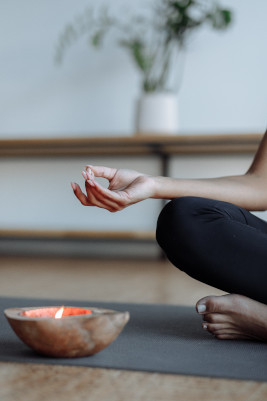
The Anahata Chakra. (The Heart Centre) Is the element of air bringing in sharing love, devotion, selfless service, and compassion.
It is my Chakra as my Zodiac is Libra. Libras can feel very emotional and can have a weakness for chesty problems. I found after having a Pulmonary embolism many years ago that it strengthened my lungs and improved my lung capacity.
Breathing sustains life. Natural breathing brings heath, happiness, and renewal. We can not see the air we breathe only movement by the wind.
Mental and emotional stress have all taken their toll, leading to shallow irregular breathing that can affect our moods from day to day and our health. Yoga breathing exercises help to calm the mind and teaches you how to improve the mechanical efficiency of your breathing and improve your lung capacity. It is the best way to relax and unwind after a busy day and helps you to go to sleep.
Try this opening the heart breathe meditation.
You might remember I did this at one of our seminars.
Make yourself comfortable lying down and concentrate on the rhythm of your breathing. Practice your yoga slow breathing. Make the exhalation longer than the inhalation.
Rest your elbows on the floor and place your fingertips on your Heart Centre.
Begin gradually breathing in and lifting and opening the hands gesture. Exhale bringing the fingertips back to the Heart Centre. Continue the process! Moving the hands further out with each inhalation forming an arch over the chest. Slowly bring the arms to rest at your side. Then apply the Hridaya Mudra. Tip of thumb to middle finger and ring finger. The little finger remains straight. First finger curls. Now breathe awareness into chest area.
The Mudra diverts the flow of Prana from the hands to the heart.
Breathe coolness into the head, breathe out and maintain the coolness in the head.
Breathe warm into the chest, breathe out and maintain the warm in the chest.
Breathe love into the heart centre, breathe out and share that loving feeling with someone you love.
I hope you find it relaxing and energising.
Love to all and Bright Blessings
Christine.
December 2023 Theme
Christmas Eve Meditation
By Sue Hargreaves

Time your meditation to suit yourself (between the times of 7 and 9pm if possible).
Give yourself 10 minutes minimum for your meditation.
Read and absorb the words of this meditation:
Sitting comfortably I turn my attention inwards
I am aware of any sounds within my body, any vibrations.
I am aware of thoughts moving through my mind.
The speed of my thoughts begins to slow as the sound of my breathing takes me into a
calmer state.
I feel warmth in the base chakra, which spreads upwards with each breath, to my belly,
then my heart centre.
I allow the heart centre to open and feel freedom and space.
Then my breath moves to the shoulders and neck, bringing warmth to my head.
I feel it dissolving any tension.
I focus my attention on a radiant light within me and allow my mind quiet thoughts of
peace
Slowly my mind becomes like the surface of a lake, completely calm without ripples,
totally still.
I experience a deep silence as I become aware that I am at peace.
As I breathe, I spread the power of that light, of that peace, across the world.
Continue the calm and focused breath and slowly close down each chakra from the crown to
the base, sealing it with a cross or a kiss, bringing yourself back to your base/ root/ what you
are sitting on, grounded, safe and secure .
Love and Light to you at this special time of year
Enjoy happiness
Sue
November 2023 Theme
By Anne Bailey
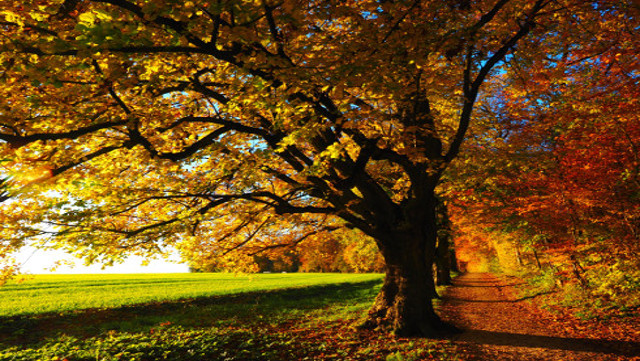
November is the 11th month of the year and the last month in Autumn. It begins with the fireworks of Bonfire night on 5th and the remainder of the month is when we’re busy making plans for the Winter Holidays – and wondering how we’ll get it all done. We can get caught up in all the busyness of preparation and begin to feel frazzled and off-balance. We want to buy the perfect presents, prepare the most enjoyable food, have the perfectly decorated house etc. This striving for unobtainable outcomes increases our stress levels and feelings of being overwhelmed. We are, at best, last on our to-do list and often don’t even consider our own well being. Self-compassion and nurturing are never wasted and both are needed at this time of year more than ever. So, when making preparations and buying presents, we could try to focus only on the process. What if we also tried to not attach expectations to the outcome – which is something beyond our control anyway. This would surely decrease the pressure we often feel at this time of year. So, my suggestion for a practice Theme for November is Action Without Attachment to Results. If we can achieve this, even for a few moments, it can bring a sense of freedom and release. The theme is only a suggestion – some parts may resonate with you and some might not – so let the ones that don’t resonate with you go.
Note: Precautions, contra-indications, counter poses and modifications have not been provided. Please choose postures and practices that suit you.
Practice postures to consider: You may want to include postures in your November practice that typically create heat. So, after some gently limbering preparatory postures, you could practice: Sun Salutations – kneeling or standing (adapt as necessary) warrior poses and variations, triangle and side angle pose, plank and its variations, locust and its variations. In your cool down-phase you may want to consider supported bridge posture, sphinx, happy baby, cobbler pose and Viparita Karani (legs up the wall pose).
Practice opening: In your practice today try to be in your body and not get caught up in your busy thoughts. Accept your body’s limitations and be grateful for what it can do. Never sacrifice your body to achieve a pose. Make an effort without giving yourself the pressure of having to achieve anything in your practice. Reduce any self-imposed pressure and keep things simple. Most importantly enjoy this time on your mat.
During asana
- Make an effort whilst remembering that the effort is more important than the shape of the final pose
- As you enter each pose, try to do so with kindness – accepting any limitations that you may have today
During rests within the asanas
- If you’re a Type A personality, you may find resting and pausing during practice a challenge – if this is the case for you today, accept this with kindness and acknowledge the effort you’re making to slow things down
- Remind yourself that you don’t have anything that you must achieve in practice today.
Breathing practice or Pranayama – the choice is yours . . .
Breathing practice: Begin by allowing your breath to settle, then notice the in-breath and the out-breath. Continue to notice these with a gentle awareness and sense the subtle movements in your body. When your mind wanders, gently guide your attention back to your breath. Aim to do this for 5 minutes if possible, then release your attention on the breath and rest for a few moments.
Pranayama: again, keeping things simple – Sama Vrtta (equal in breath and out breath) for a few minutes followed by Nadi Shodhana. Dhyani Mudra – place both hands in your lap with the left hand inside the right hand and thumbs lightly touching each other like a bowl. Or if you prefer Vishnu Mudra – using the right hand only, little finger and ring finger extend long with the middle finger and index finger curled in towards the palm.
Meditations – simply watching the breath – practice this for 5 to 15 minutes – become aware of how many breaths you can notice in a row before your mind wanders, but don’t judge or criticise yourself – just notice. Alternatively, if you don’t feel comfortable focusing on the breath, you could find a favourite quote to contemplate on during meditation.
Relaxation/Savasana – Autogenic relaxation
At the end of practice/waking up after relaxation:
Pause for a moment here and consider all the ways that your body has moved for you during practice, all the ways it has moved throughout your day, how your legs have carried you, how hard your hands have worked. Set an intention for the rest of your day to act without attaching to an expectation of any particular outcome to those actions.
Nadi Shodhana
This technique is helpful for calming the spirit and mind. With Nadi Shodhana you can imagine breathing in positive energy and exhaling negative stress from the body. Nadi shodhana aims to help circulate breath through the nadis, which can help us to feel more balanced. This practice is thought to stimulate the ajna (third eye) and muladhara (root) chakras as well as balancing the ida (left) and pingala (right) nadis.
- Sit in your favourite supported position, with the spine upright but relaxed and an open heart.
- Using the thumb of the right hand, gently close the right nostril and breathe in evenly through the left nostril.
- Once the inhale is complete, close the left nostril gently (with the little finger and ring finger), open the right and exhale through the right nostril.
- Keeping the right nostril open, inhale through it.
- Then close the right nostril, open the left nostril and exhale through it.
- This is one round – you can practice up to fifteen rounds if you have the time.
Autogenic relaxation
- Come to rest in Savasana, if this isn’t suitable sit in a supportive chair.
- Relax by deepening your breath and releasing any residual tension.
- Begin to silently say to yourself:
“My right hand is heavy; my right hand is relaxed, warm and heavy; my right hand is completely soft and relaxed”. Repeat a total of 3 times.
Then move onto your left hand in the same way.
“My left hand is heavy; my left hand is relaxed, warm and heavy; my left hand is completely soft and relaxed”. Repeat a total of 3 times.
Continue this autogenic relaxation with the following areas of the body.
- arms
- feet
- lower legs
- thighs
- buttocks and lower back
- chest
- abdomen
- shoulders
- neck
- head
- face
- my whole body is relaxed and warm
Rest completely relaxed for a few moments before gradually and gently breathing awareness back into your body. Begin by slowly deepening the breath. Then bring some small movements into your fingers and toes. If you wish take a full body stretch. If lying in Savasana, bring one knee to the chest and give it a hug. Next, bring the other knee up to the chest and give both knees a hug – gently rocking from side to side. Slowly roll to one side and pause for a moment to consider how your body is feeling after practice. When you feel ready slowly come to a seated position and take as much time as you need to transition to standing.
References:
Thick Nhat Hanh (1993), The Blooming of a lotus, Beacon Press Books
Jenny Sutcliffe (1993), The complete book of relaxation, Quatro Publishing
October 2023 Theme
By Nirmala Molloy

When Sue asked me to do a piece on October for the CYTA website, I began by making a list of all the things that reminded me about October and makes me smile inside with warmth and gratitude! Here are a few:
- Autumnal walks
- Leaves changing colour with hue of ambers and ochre.
- Earthy autumn smells
- Swishing trees, not entirely shed of leaves
- Cooler clean air
- Log fires with winking embers that take us to a place of serene contemplation.
- Pumpkins and pumpkin soup
- hot chocolate with marshmallows
- Warm fuzzy blankets
- snuggling up with our pets
- slowing down and returning to ourselves ………
As we leave the planning and excitement of summer behind and come into the cooler raptures of October, we gently and gradually become aware of a sense of withdrawing inwards, a sense of detachment and slowing down.
As with nature, we begin by connecting with our inner selves, getting to know ourselves as we are now. Perhaps, sheading what is not needed, the old us, and watching and waiting to see what may be revealed by our deeper selves. A new phase of adaption, as we align our energies in harmony with nature. We are not required to do anything, just to wait and see what joys will be revealed. Autumn like spring is a season of transition, letting go and aligning with our heart space. Moving into something more softer and mellow, guiding us to move our attention inwards where we can find quiet reflections, and waiting for the whispered messages to come into our consciousness.
Days become shorter and a sort of melancholy enters our beings. Changes in the rhythms of nature also include changes within us.
A walking meditation
Through practice we can develop the capacity to tune into the harmony of autumnal October. As we step outdoors, walking unhurried in the woodland with a natural pace, listening to the sounds of our own breath and the footsteps with which we tread upon the moist earth. Watching the breath as we notice the pause before the exhalation which then transforms itself into a new inhalation. The outdoor woodland bringing all our senses into focus. The scents of the bark, the softness of the skeleton leaves, the vibrant colours of yellows, oranges, reds, crimsons, and purples. The sharpness of the cool air upon our face reminds of life, freshness, and vitality.
So here’s to encouraging you all to step outside, and enjoy the wonderful outdoors, away from the noise and hurriedness of urban life and into the calm serenity of nature.
Enjoy!
Nirmala
September 2023 Theme: Autumn
by Judith Lynch
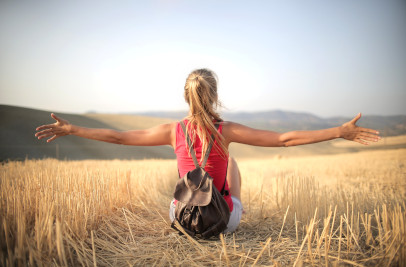
llow us to feel free and open to new things. Maybe make an intention to change one small thing eg change the route you normally travel to the supermarket.
Perhaps start a yoga practice with a simple mind/body exercise to help with concentration eg draw a figure of 8 on its side 3 times in the air, first with one hand, then the other. This will also ease the neck and eye muscles. Move onto shoulder, arm, hip and leg warm-ups.
Air and the sense of touch are connected and asanas using soft opening of the hands and arms are appropriate to give a sense of the uplift which air provides. Focussing on the breath and opening the chest and heart are also key elements of the postures below.
- Eagle pose. Inhale and expand into your upper back, encouraging the shoulder wings to move apart, relax heads of shoulders as you breathe out. Repeat then change sides.
- Trikonasana. Focus on allowing the breath to open your chest so that you feel light in the upper trunk. You could also try flowing the in breath out through the fingertips of upper hand and the out breath down to your lower hand to appreciate the posture shape and the energy flow.
- Breathe more deeply to support the stamina and strength needed for parsvakonasana. Perhaps add on some flow lifting into Warrior 2 as you inhale and back to parsvakonasana on exhalation.
- Matasyasana – the fish pose lifts the heart high, allows more air into the chest and expands the heart space. Focus on slow breathing and deeper awareness of the life-giving breath.
Any breathing techniques/pranayama exercises are obviously very appropriate to practise at this time of year. The relationship between the mind and the breath is of course important for mental as well as physical health.
I am including a short meditative sequence suggested by Callie Glover with hands in Garuda Mudra – the eagle gesture. This could be used at the beginning or the end of your practice.
- Sit comfortably with straight back, relaxed shoulders.
- Cross wrists, palms facing and place flat on chest interlocking thumbs. Tune into your heartbeat.
- Bring hands away from chest. Exhale bending fingers towards palms
- Inhale keeping thumbs interlocked and stretch fingers out like eagles’ wings.
- Visualise the rhythmic pumping of your heart circulating blood throughout your body.
- Repeat for 10-15 breaths.
- Sit with hands on your heart giving thanks to your hard-working heart and for your breath.
Namaste
Judith Lynch
August 2023 Theme: Harvest Time or Summer Joy
by Lisa Hargreaves

August is a wonderful month filled with such great abundance. Mother nature is transitioning from the hot long days of Summer to cooler shorter evenings of Late Summer; her bounty reminding us to be appreciative and grateful at harvest time. There are even two full moons! This pivotal point of the year gifts us the generous opportunity to pause and re-balance ourselves.
Our practice this month will reflect balance and gratitude for the fruits of our labour.
The beginning of August is filled with such great abundance of cheerful warm sunshine, the smells of flourishing garden flowers and salty ocean breezes, the yellows of warm sand, zingy citrus fruits and the golden wheat fields ripe for harvesting.
Our yoga practice may be influenced by the fire element to stimulate circulation and ignite our agni (inner fire) to burn through any held tension.
Note: Precautions, contra-indications, counterposes and modifications have not been provided. Please choose poses and allow the pose to suit you.
Summer
Intention: Maybe you would like to set an intention to include joyful smiles, or plant a mental seed (bija) to reap later at next year’s harvest time.
Affirmation: An affirmation could be “I am enough just as I am”
Mantra to use in pose: Inhale “Happy” Exhale “Content”
Asana
Main pose: Trikonasana (Trikonasana)
Focus asana on the heart centre (Anahata) by combining uplifting heart opening poses.
Please find below a suggested ’heart warming’ practice with an optional vinyasa:
Supta Matsyendrasana (Supine twist)
Bridge (Setu Bandha Sarvangasana) – moving bridge with arm stretching overhead
– bridge with 1 leg lifted
Supine Child’s pose (supine balasana)
Half Boat pose (Ardha Navasana)
Moving flow combining of Half boat pose and spinal twist ( stretching alternate leg and both arms to each side)
Cat Cow (Bitilasana / Majaryasana)
Child’s pose (balasana)
Table top pose (Dandayamana Bharmanasana)
Plank (Phalakasana)
Downward dog (Adho Mukha Svanasana)
Half frog pose (Ardha Bhekasana)
Crocodile – window wipe legs (Makarasana)
Locust or Updog (Urdhva Mukha Svanasana)
Cobra (Bhujangasana)
Crocodile – window wipe legs ((Makarasana)
Child’s pose (balasana)
Kneeling pose (Vajrasana) / Easy Pose (Sukhasana), Bound Angle pose (baddha konasana) – side stretches
Gate pose (Parighasana)
Prasarita Uttanasana (Wide leg Forward bend pose)
Mountain pose (Tadasana)
Warrior II (Virabhadrasana II)
Reverse Warrior II (Virabhadrasana II) – optional
Forward fold (Uttanasana) – counterpose with bent knees
Mountain pose (Tadasana)
Temple breath
Inhale, float arms out to the side and up overhead into Anjali Mudra.
Exhale lower hands in Anjali Mudra, down to the heart. Inhale open arms out, keeping elbows close to the ribs, palms facing up. Exhale lower arms down by the side.
Triangle (Trikonasana) – all variations
Eagle arms & legs (Garudasana)
Three part breath movement
Standing in mountain pose (Tadasana), arms by the sides, fingers together. Inhale, keeping fingers together, palms facing down, raise arms forward up to shoulder height. Exhale as you turn palms to face each other. Inhale, open arms wide out to the side, shoulder level if possible. Exhale arms back in front of you at shoulder height, turn palms face down. Inhale, raise arms straight up to the sky, palms facing forward. Exhale, lower arms down.
Half lord of the fishes pose (Ardha Matsyendrasana)
Legs up the wall pose (Viprariti kharani)
Plough pose (Halasana)
Corpse pose (Savasana)
Other poses to which are also heart opening:
Updog (Urdhva Mukha Svanasana)
Camel (Ustrasana)
Dancers pose for balance (Natarajasana
Optional heat generating (tapas) vinyasa:
Sun Salute which includes 3 legged dog into revolved triangle:
Prayer pose (Samasthiti)
Mountain pose (Tadasana)
Forward fold (Uttanasana)
Flat back pose(Ardha Uttanasana)
Forward fold (Uttanasana)
Lunge (Banarasana)
Downward Dog (Adho Mukha Svanasana)
Three-legged Dog (Eka Pada Svanasana)
Knee-to-elbow Downward-Facing Dog
Revolved triangle (Parivrtta Trikonasana)
Three-legged Dog (Eka Pada Svanasana)
Downward Dog (Adho Mukha Svanasana)
Lunge (Banarasana)
Forward fold (Uttanasana)
Flat back pose ( Ardha Uttanasana)
Tall mountain (Tadasana)
Prayer pose (Samasthiti)
Eagle arms & legs to counterpose
Vrksasana (tree pose) – with options
Legs up the wall pose (Viprariti kharani)
Plough pose (Halasana)
Supta Matsyendrasana (Supine twist)
Corpse pose (Savasana)
Be playful, be kind to yourself (ahimsa- Patanjali sutra 2.35) by listening to what your body needs. Maybe try moving with your own breath (letting the pose fit you, rather than the pose directing your breath) or step out of the comfort zone and be open to trying a new pose or sequence. May your self thoughts be kind.
Pranayama mudra: Gyan, deerghaswara sharira
Image 2:
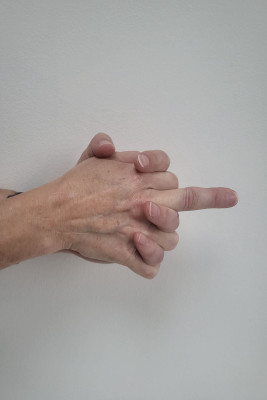
Pranayama Mantra: Inhale “Happy” Exhale “Content”
Pranayama:
1st step: Place hands in Gyan mudra to aid with focus. Begin with a few equal ratio breaths to settle. When comfortable, lengthen the exhale. Count down rather than up for a change, to help calm the mind for a better sleep.
2nd Step: When settled, follow the Golden Thread using your favourite colour Hands placed in deerghaswara sharira mudra, with the option of incorporating Sitali to bring a cooling balance.
Meditation Mudra: Dhyani
Meditation: Heart Connection meditation (attached).
Relaxation: Maybe a heart chakra yoga nidra.
End practice quote:“when we feel love and kindness toward others, it not only makes others feel loved and cared for, but it helps us also to develop inner happiness and peace.” Dalai Lama xiv
NB: Use blocks and blankets generously
Late summer brings balance with a return to our connection with thhttps://cyta.yoga/book-reviews/e earth at harvest time. A gentle reminder to take pauses in our day and just observe the sensations of the ground and the world around us through our physical bodies. Pause – which part of your feet do you notice touching the floor? (Annamaya Kosha).
Colours begin to transform to the reds, blues and purples of summer fruits and berries. Calming lavender, rosemary and damp earth scent the air. Pause – take a breath, pause, slowly breathe out. What can you smell? (Pranamaya kosha).
As the sun now rises a little later and goes to bed a little earlier, you may feel a sense of slowing down. With it, our energy begins to flow from yin fire to yang water; our focus begins to move from energetic external and to compassionate internal.
Harvest time is a perfect time to check our body batteries ( as well as our mind and spirit energy levels). It provides another opportunity to celebrate our beautiful selves and the wonderful fruits of our labours. Pause – Take a moment to ponder where you have been directing your energy all year. What positive tasks have you achieved or events you have experienced? Notice what emotion you feel (Manomaya Kosha). Notice where you feel that emotion in your body.
August’s abundant second moon – a cooling Blue moon, signifies a time of release and renewal. In yoga tradition Apana vayu is associated with the earth element and letting go. Pause – When was the last time you noticed your thoughts? (Vijnanamaya kosha). Note if the thought is negative. Find an opposite thought, then embody this emotion. Take a deep breath. Focusing on our breath during our practice or pause in our day, is a wonderful anchor to help us feel grounded.
One method of ‘grounding’ ourselves whilst learning to mentally, physically or emotionally let go is by integrating a gratitude practice into our daily routine.
The ways we can honour our abundance is by cultivating self compassion, contentment (santosha – Patanjali sutra 2.42) and joy. Pause – (Anandamaya kosha)
“Contentment nurtures happiness.”
Focusing on gratitude – for our harvest, the invisible things and people who help us, even the small things we achieve every day, helps us to let go of unwanted thoughts and worries, restores our batteries, become more mindful, present and helps with a better night’s sleep. Pause – When was the last time you said thank you to yourself, for the little things that bring contentment or felt joy? Recall a moment which makes you feel joy. (Anandamaya kosha). Notice where you feel that in your body.
Our yoga practice may be influenced by the earth element to provide you with stability and joy.
Note: Precautions, contra-indications, modifications and counterposes have not been provided. Please choose poses and allow the pose to suit you.
Late Summer
Intention (Sankalpa): Maybe you would like to set an intention to say 3 things you are grateful for each day .
Affirmation: An affirmation could be “Silence and stillness bring contentment and peace” or “Change begins with me”.
Mantra to use in pose: “OM” for connection to the earth and calmness.
Asana
Main pose: Half Moon pose (Ardha Chandrasana)
Focus asana on the earth element, integrating grounding and stability poses – (muladhara, sthira and sukha).
Please find below a suggested ’cooling’ practice with an optional vinyasa:
Baddha Konasana (bound angle)
Supta Matsyendrasana (Supine twist)
Bridge (Setubandha Sarvangasana)
Cat Cow (Bitilasana / Majaryasana)
Lizard pose (utthan pristhasana)
Pigeon(Kapotasana)
Downward dog (Adho Mukha Svanasana)
Mountain pose (Tadasana)
Utkata Konasana (goddess pose)
Utthita Parsvakonasana (extended side angle)
Triangle pose (stability) (Trikonasana) – all variations
Salute to the Earth breath (Prithvi namaskar)
Standing in mountain pose (Tadasana) Interlace fingers, palms up. Inhale, raise palms up to the heart. Turn palms down, Exhale as you lower the palms down. Inhale as you turn palms forward and raise up overhead towards the sky. Exhale as you release the fingers and lower arms out to the side and down.
Vrksasana (tree pose)
Utthita Hasta Padangusthasana (extended hand to big toe pose)
Warrior III (Virabhadrasana III)
Warrior II – revolved (Parivrtta Virabhadrasana II)
Half Moon pose (Ardha Chandrasana) & all variations
Eagle arms & legs (Garudasana)
Bow to the earth (Tadasana and Utkatasana or Malasana)
Place hands in Anjali mudra, inhale as you raise your arms overhead, focusing on the space above the crown chakra (sahasrara). Long exhale, lower hands to the third eye chakra (Ajna), then the throat chakra (Vishuddha). Bend the knees into chair pose (Utkatasana) or squat / Garland pose (malasana) and bring the prayer hands to touch the floor for a few breaths. Silently thank the earth for supporting you. Inhale to come back up to Mountain pose (Tadasana) raising prayer hands overhead. Exhale and lower hands back to the heart.
Note: This movement can be used in other poses such as Warrior I (Virabhadrasana I), Goddess pose (Utkata Konasana)
Head to knee pose (Janu Sirsasana)
Legs up the wall pose (Viprariti kharani)
Plough pose (Halasana)
Supta Matsyendrasana (Supine twist)
Corpse pose (Savasana)
Bring balance to the Summer practice by including this Moon salutation vinyasa: Mountain pose (Tadasana)
Upward salute pose / standing crescent pose (urdhva hastasana) – stretch to each side
Goddess pose (Utkata Konasana)
Triangle pose (Trikonasana)
Pyramid pose (Parsvottanasana)
Crescent lunge (Anjaneyasana) with back knee downhttps://cyta.yoga/book-reviews/
Side lunge (Skandasana)
Repeat in reverse
Throughout the practice or in a pose, focus on the exhale, flowing down the spine, down the legs and out through the feet. This helps direct prana downwards.
Focus on feeling where your feet or body touch the ground.
Pranayama mudra: Nasikagra / Nasagra Mudra
Pranayama: Chandrabheda or Triangle Breath
Pranayama Mantra: “OM”
Meditation Mudra: Dhyani
Meditation: Trataka using an apple or a berry.
Relaxation: Anandamaya kosha Joy yoga nidra (attached)
End practice Quote:
“For as the earth comes from the waters, plants from earth, and man from plants, so man is speech, and speech is OM … This is the essence of essences … OM is the Self of all…. For those who meditate on the imperishable OM, all desires are fulfilled…. This Self who is joy abiding… is ever present in my heart.” The Chandogya Upanishad
NB: Use blocks and blankets generously
May the contentment you feel at the end of your yoga practice energise you, and bring peace to your day.
Namaste🙏💖🕊️
References:
Image 1 https://www.pexels.com/photo/woman-sitting-while-showing-heart-sign-hands-1535288/ [28/07/23]
Image 2 – LJ Hargreaves hands [30/07/23]
Golden Thread Breath Pranayama
If you’d like to find a comfortable posture –
*- sitting cross legged, hips higher than the knees, with a blanket under ankles, blocks under knees
*- on a chair with feet resting on blocks
*- supported by a pillow or the wall
*- if you have a back condition, please feel free to lie down.
If you are sitting upright:
lift your spine upright
relaxing your forehead
relaxing your jaw
relaxing your shoulders
allowing your breath to settle
If you wish to, place your hands into chin mudra.
Image 3:
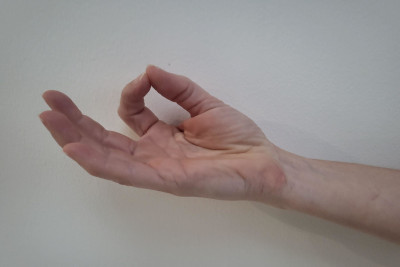
– index fingertip touching the thumb tip, other fingers together. hands are relaxed and resting with the palms up on the thighs or a cushion.
If you’d like to, place a small smile on your face and gently close your eyes. If you are feeling sleepy, try keeping the gaze lowered.
Give yourself permission to move to a more comfortable position, and release the mudra, at any time.
With this breathing practise the exhalation is lengthened to calm the nervous system, which calms the body and mind. It takes the panic or stress out of a difficult situation and is often used in labour. It can help you relax when facing those moments when life feels a little overwhelming.
We will be breathing in through the nose, and out through the mouth.
It can either be through slightly parted lips, so you open your mouth just a tiny bit, just enough so a sliver of paper could fit between the lips. relax the inside of the mouth and your jaw completely.
So we will be inhaling normally through the nose and exhaling through slightly parted lips or pursing the lips a little to blow the air out, so softly and gently.
Let us begin:
Breathe in through the nose, and either just slightly part the lips and feel the breath leaving, or pursing the lips and gently blowing out.
And what we are going to do as the breath leaves the lips, is visualise a fine golden thread spinning out on the breath.
Visualise the golden thread spinning out and away into the air around you, for as long as the breath will comfortably carry it.
Let the focus of your attention remain really precise.
Let it start at the out breathe, on the lips, and then allow it to travel out into the air along your golden thread, for as long as the breath, and your mind can comfortably carry it.
It’s about lengthening the ‘out’ breath, gently and softly.
Gently and softly.
See your golden thread just spinning in the air, just as if you are in a meadow, outside on a sunny evening, where you can see the spider threads in the air and the sun’s rays dancing on the warm golden wheat in the fields.
Let your delicate golden thread spin out, like a silken thread and let it be gently carried in the air.
Pause – breathe your golden thread.
If you wish, you may prefer to choose your favourite colour.
Breathe out your coloured thread. Lengthening, floating into the evening summer air.
Helping the relaxation response to come.
Helping to really slow down and relax inside.
At any time you can stop, but always make the breath comfortable. Never any strain.
Let’s now release our focus on the golden thread breath and let your hands relax to release the mudra.
Wiggle your fingers and toes.
If you need to change your position at all, please do, as we will now begin our meditation.
Reference
Image 3 – LJ Hargreaves hands [30/07/23]
Heart Connection Meditation
If you’d like to find a comfortable posture –
*- sitting cross legged, hips higher than the knees, with a blanket under ankles, blocks under knees
*- on a chair with feet resting on blocks
*- supported by a pillow or the wall
lift your spine uprighthttps://cyta.yoga/book-reviews/
If you wish to, place your hands into Dhyani mudra, the classic meditation pose – resting your hands in your lap, maybe supporting them with a cushion, palms facing up, the left-hand resting in the right, thumb tips gently touching.
Give yourself permission to move to a more comfortable position, and release the mudra, at any time.
Invite yourself to fully arrive right here and now. Let the world melt away as you gently close your eyes or lower your gaze.
Focus on the breath moving naturally. Letting the breath find an easy natural rhythm. Often we move faster than the rhythm of life. So let yourself slow down as you breathe.
Soften your face, your chest, your belly, your hand letting your body settle down into the surface below. Allowing yourself to be held by the Earth by the support underneath you.
Softening the body. Allow your centre of gravity to drop out of the field of thinking and into the aliveness of the body. Opening to the mystery of this moment.
Turning into your own inner landscape as you notice sensations that are here: temperature, movement, background sounds, just noticing what’s alive in your body as you breathe and are held by the air.
And allowing things to be just as they are no need to fix or change or make anything better. Just opening to your current present moment experience.
Bring one or both hands to lie on your heart centre.
As you take some full breaths into the heart space, feel the breath filling your heart space – all the way to the back of the heart as you turn in, plugin and awaken your connection to your own wisdom, your own power, your own love.
Giving yourself permission to feel any emotions or breathe into any stagnant energy. Feel the energy in your body release and flow freely, as you breathe with your heart.
Feel your heart space reset as you breathe and soften into your edges.
Gently release the concentration on the heart space.
notice how you feel without any judgement.
continue to sit restfully. inhaling and exhaling slowly.
begin to wiggle your fingers and toes or other intuitive impulses the heart and body are asking for as you take deeper breaths.
Returning to the present moment, feel gratitude for this time to connect with yourself. Take with you the feelings of love and support. remembering that you are always being held.
Keeping your eyes closed, bring your hands together and rub the palms together, feeling the heat of prana.
Place your hands over your eyes to refresh you.
Gently open your eyes behind your hands.
Keeping your gaze lowered, lower your hands into anjali mudra.
Gently smile and bow your head
As you continue with your day, contemplate the affirmation:“I am enough just as I am.”
Joy Relaxation
Wrap up warm, put layers on or a blanket.https://cyta.yoga/book-reviews/
Move into a comfortable relaxation position.
If you lie on your back, have a wiggle to lower your back. Try putting your arms out, palms up – a symbol of letting go. Gently closing your eyes.
Let the floor take the weight of your body. weight evenly distributed, feel as if you are melting and sinking into the ground, as you release & relax deeper. Gradually you will feel a sense of stillness rising in you effortlessly.
Bring your attention now to your breathing & take a few deep abdominal breaths to help you relax even deeper. Notice how your abdomen rises with each breath in & lowers with each breath out. As you become more and more relaxed, notice that your breathing will naturally become slower and slower.
As your body relaxes deeper and deeper, the mind remains still and alert. If you find yourself drifting off, bring your awareness back to your breath with compassion and without judgement and do this as many times as you need. Knowing that as we train our bodies in asana, we are training the mind in relaxation.
As you bring your awareness into the body, allow the muscles to relax without force of will and allow the mind to be still without effort.
Mother Teresa says: ‘Peace begins with a smile.’ So if you would like to welcome a small smile on your face, as we welcome joy into our relaxation.
What feeling immediately comes to your heart? Not a thought to your mind but a feeling to your heart. Joy is always within us, just waiting to be tapped into. Waiting to bring vital warmth to ourselves and to cast its spell on all who cross our path. Love, kindness, spirit, liveliness, are all states that radiate from us when we are feeling happy.
Take a moment to notice how you are feeling now. Notice where this feeling is in your body.
As you breathe in, scan your face, eyes, jaw and throat for any tension. Take a long deep breath out.
With your next breath in, scan your shoulders, your hands and fingers. Breath out.
Take a deep breath as you scan your chest, your heart, your upper back. And then release.
Breath into your solar plexus, the point between the ribcage and the navel and into the area around your middle back and wait ….and exhale slowly.
Breathe in, scan your belly, your lower back and hips and a long breath out.
Another deep breath in and scan the body, the back of the thighs, the front of the thighs, the calves and Shins. Exhale all the stale air.
And with another deep breath in, scan the ankles, the soles of the feet and the toes. Imagine all of the fatigue and strain releasing through your toes
As you lie here taking long deep breaths, quietly whisper to yourself:
Breathing in I calm my body
Breathing out I smile
Breathing in I calm my body
Breathing out I smile
Breathing in I calm my body
Breathing out I smile
Breathing in I calm my body breathing out I smile
Breathing in I calm my body breathing out I rest
Breathing in I calm my body
Breathing out my rest
Breathing in I calm my body
Breathing
Now bring your attention to your eyebrow centre. Envisage an image of someone, something or somewhere that makes you feel great joy.
Bring your attention to your heart and notice how you feel. Bring your attention to your belly and gently soften your belly. Constantly let go of any tension you’re holding on to.
Soften your whole body. Breathe with ease. And notice how your heart is responding.
Remember to smile. It costs nothing and creates much riches for those who receive it. It happens in a flash but the memory of it lasts forever. It creates happiness in the home, fosters goodwill, and is the sign of friendship. It is nature’s best antidote – for it cannot be bought, begged, borrowed or stolen. Where it is something that is no earthly good to anybody till it is given away. If someone is too tired to give you a smile, leave one of yours. For nobody needs a smile so much as those who have none to give.
Start to breathe a little deeper
Wiggling your fingers and toes
Rolling your head from side to side
Raise your arms and have a good stretch
Close your hands into fists
Stretch your hands
Bring palms together, rub your hands and place over eyes
Bring palms together again, rub your hands and place over eyes, lower your hands.
When you are ready, roll on to your left side
Keeping your eyes closed, come up to sitting
Slowly open your eyes, keeping your gaze lowered
Take a moment to notice how you are feeling now, compared to the beginning
Pat your hands over your leg, then up over your arm
Place your hands in to anjali mudra, palms together in front of your heart
Gently smile and bow your head
Thank yourself for making time for ‘you’ today
Namaste
July 2023 Theme: A Cooling Practice
by Kathryn Smith
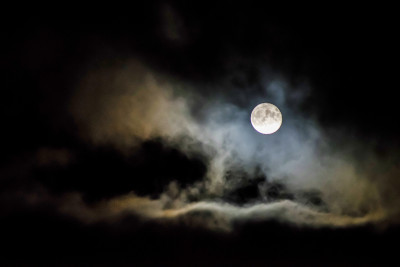
July is a quieter month as most others have traditional celebrations attached to them. July’s absence of such was not a time of relaxing but of haymaking for our ancestors; which usually involved the whole community, ensuring that the animals would be well fed throughout the Winter.
July’s full Moon is known as Wyat (herb) or Mead Moon and occurs on July 3rd. This is a supermoon which is bigger and brighter than other Moons.
July’s New Moon will be on the 17th. Astrologers believe that this New Moon is a quiet, contemplative time before a phase of growth.
Each New Moon has its own energy and the Cancer Moon is said to rule home, family and domesticity.
In the lunar calendar the fourteen days before the full Moon are known as Shukla Paksha (the bright fortnight). The fourteen days after are known as Krishna Paksha (the dark fortnight).
The Moons energy is Ida; cooling, creative and relaxing in its qualities. Ida energy is introverted, feminine; contains the mental force and consciousness.
Cooling Practice
1. Begin your practice sitting in Swastikasana or a comfortable seated position where the spine is lifted. Sit well.
Place your hands in Yoni (womb) mudra (hand gesture) by steepling your fingers and pointing them down. Keep the thumbs and forefingers where they are and interlock the three remaining middle, ring and little fingers so that you have formed a diamond shape with your thumbs and forefingers.
This mudra balances body and mind, develops deeper concentration and awareness, stabilises meditation and promotes internal relaxation.
Sit here and feel the breath, watching it passively.
When you feel ready, you can release the mudra and stretch your legs out.
2. Coming into Adho Mukha Virasana now from all fours, rocking to go down (which soothes the nervous system) exhaling back a bit more each time until your bottom reaches your heels or blanket/block. Place the hands palms down about a foot/30 cm from your knees. Lift the fingers and push with the heels of the hands to stretch through the back. Head is up, looking towards the end of the mat. Breathe here for a few moments, then return to all fours.
3. Moving on to Uttanasana; place your fingertips, down (or use bricks if you cannot reach the floor), step forwards lining up the outer heels with the outer edge of the mat (so the feet are straight), elbows bending sideways, knees bending forwards, relaxed, dangly head. Inhale as you lift the heels to straighten the legs (arms straight too) and lift the kneecaps. Exhale the heels down keeping the outer feet straight. Lift the head, stretch the sternum forwards; weight in balls of feet and come up to Tadasana.
4. Stand well in Tadasana. Feel grounded and lift up through the body.
5. Into Vrksasana, standing on the right leg first. Left foot to the right ankle, calf or thigh; hands over the head , palms facing or in front in Namaskara mudra. Holding the gaze steady once in the pose to quieten and aid balance. Coming back to Tadasana, before repeating standing on the left leg. Returning to Tadasana.
6.Place a brick (or block underneath the brick if you know you cannot reach) at both sides of the rear of the mat. Take the feet apart for Trikonasana. Turn the left toes in slightly by coming onto the heel to swivel the foot (which will protect the hip) and with the same movement take the right foot out. Check your brick is in the correct position by your right ankle. Take the arms out and close the eyes. (Closing the eyes in this pose keeps it quiet and you can feel the pose better). From Parsva Hasta Tadasana, take a breath in stretching the arms and with an exhale go down to the right. Place your right hand on the brick and bring your left hand into your waist. Head wherever is comfortable. Encourage the right side of the ribs to move to the left, relax the left shoulder back and take the left hand into the air. Hold for a few breaths if you can before returning to Parsva Hasta Tadasana. Open the eyes, bring the arms down and turn the feet to the front. Come to Tadasana before repeating on the left side then return to Tadasana and just be here, breathing.
7.Take yourself down to the mat in Savasana. You can bend the knees or have the calves on a chair seat. Be comfortable. Use a blanket as you will cool down quickly after the asanas.
Take your attention to your breath. Let it settle.
1.Breathe in for the count of one, exhale with control.
2.Breathe in for the count of two, exhale with control.
3.Breathe in for the count of three, exhale with control.
4.Breathe in for the count of four, exhale with control.
Return to 1.
Continue for up to five minutes and then return your breathing to its own rhythm.
8.Visualisation: MOON.
You are standing before a lake. It is evening and the full silver Moon is perfectly reflected in the still water. The air is fresh and silent, save for the gentle rhythm of your breath. You look up to the Moon, at its light and dark patches so far away. You look at its reflection on the water – so big and round and full. A gentle breeze stirs the waters and the Moon shimmers and winks at you. You look back to the Moon and feel its gravitational pull. The lake responds and the Moon ripples, its shape disturbed.
You watch as tiny sparks seem to emanate from the Moon, shafts of silver moonlight descending down to land upon you. You feel the tingle on your skin as the Moons beams touch you; bathing you in a soft, silvery sheen. Feel the energy from the Moon. Feel as its soft rays sink into your body. Feel the beams sparkling within you; healing, restoring, lighting up your very being. Feel yourself absorbed in the Moons silvery gleam.
Then you feel the rays leaving you and once more they are evident in the sky as they travel back to the silvery ball. You watch as the beams merge back into the full Moon. You look again at the Moons reflection which dances in the breeze, winking at you once more. A cloud passes over the Moon, stealing it from your sight. You stand here, for a moment, before turning away from the lake and stepping gently back onto your Yoga mat and back into your own body.
9.When you feel ready, take a breath in and on the out breath bring your right hand onto your body. Take a breath in and on the out breath bring your left hand onto your body. If your legs are stretched out, with two separate exhales bend your knees so that your feet are flat on the mat. If your legs are on a chair, inhale the knees towards you. Exhale as you roll onto your right side and with your eyes still closed bring yourself back to Swastikasana or a comfortable sitting position and exhale as you lower your face down. Take a few breaths here, sitting well and feeling the difference from the start of your practice. Inhale as you slowly open your eyes and lift your head.
Namaste.
June Theme 2023 – It looks like summer arrived!
by Sue Hargreaves
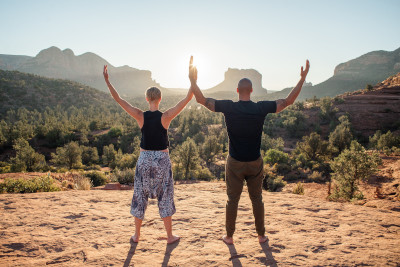
In Ayurveda , this is the Pitta time of year when energy continues to increase. It is wise not to ‘overdo’ things and so I have given a simple short yoga practice to help to keep us in balance.
Note- I have not given precautions , so be aware of what is suitable for any conditions you may have as an individual, that may not suit this practice.
Sitting
Sitali Pranayama (cooling breath)
Hands at our Anahata Chakra (Heart centre) breathing steadily & focusing on the body and then the breath>
- Sit with palms on knees
- Extend the tongue & fold the sides to form a narrow tube
- Inhale deeply & slowly through the folded tongue
- Close your mouth while you hold the breath for a short hold and then exhale through your nose.
- If you are unable to to curl your tongue , just extend it slightly through your lips and sip in the air across its upper surface
- Repeat 5 to 10 times
For those used to more advanced Pranayama, you can perform Jalandhara bandha (Chin Lock)
- After a short hold, release the bandha & exhale through the nose
- 9 rounds
Figure of 8 with nose> ears to shoulders>
Eye exercises- Looking up, looking down, looking right, looking left , looking diagonally up to the right and then down to the left, repeating in the opposite direction. Then imagine a clock and circle from 12 clockwise and then anticlockwise.Lastly hold your thumb about 12 inches from your face and move your eyes from the thumb to the wall beyond and back X 5 . To end , palm your eyes soothe and relax them.
Kneeling
Shashankasana (Pose of Child / Hare) – walk hands to each side for a stronger stretch
Pitta type routine key words are
cool, effortless, surrender, non-critical, moderate, holds, easy breath
- Face down back Vinyasa –
EXHALING raise head, R arm and leg> repeat on left
EXHALING raise head, R atm & L leg> repeat on opposite
EXHALING slowly lift head, both arms & legs> hold for 3 without strain.
- Dog Down pose (Parvatasana) ) X 1 short hold
- Lunge/ equestrian pose ( Ashwa sanchalanasana ) X2 each side
- Wide legged forward bend X 1 longer hold
- USING CHAIR- standing twist – foot on seat with same side hand of top of your thigh , twisting as you follow your other raised arm to wrap around your waist
- Pose of child short hold
- Face down back Vinyasa again
- Pose of child short hold
- Hero pose (Veerasana)
- Leg Raises X 3 each side with long hold
- Lying twist- your own version
- Corpse (Savasana) 10 mins
May 2023 Theme
by Jackie Hudson

May comes from the Greek Goddess, Maia. She was a nurturer and earth goddess who ensured the plants and flowers danced their way to full bloom before the arrival of summer. These days we celebrate with May Day bank holiday although we have been celebrating this wonderful time of year for over 2000 years with Maypoles and garlands, rose queens and kings and various parades and parties. The Celts refer to the time between spring equinox and summer solstice as Beltane (Fire of Bel) and bonfires were lit to welcome the new season and despite being opposed through the centuries by both church and state many May Day celebrations survive today.
As the world begins to flourish here in the northern hemisphere we can see flowers opening their petals and trees putting on their full leaf cover. This is a great time to practice outside and connect with the birdsong, sunlight and new growth.
A great way to start the day is to get outside (weather permitting) even if it’s only for a couple of minutes – barefoot is even better. Allow yourself to come to stillness and begin to notice the sounds, smells and sights around you. Close your eyes and feel the cooler air on your skin or the breeze or sunlight (or even rain if you enjoy that sensation). Let your awareness move to your feet and connection to the earth and then feel the breath without resistance or strain – each breath arising from stillness and each breath returning to stillness.
If you wanted to continue your practice outside then your version of sun salutation for the day would be good or some mindful movement, however if you are feeling like returning indoors or prefer to sit, here is a beautiful practice that will help connect your newly energized feet to the rest of your body in a seated, flowing way.
Lotus Feet Breathing
For teaching: this is a good alternative to cat/cow for those who prefer not to be on all fours…Great for beginners as we can look at pelvic position/flexion/extension but then bringing in the breath and bandhas when appropriate.
Sit comfortably in baddha konasana, with the knees bent out to the side and the soles of the feet touching (a feeling of openness is desired in the thighs and groins but if you feel over-stretched then support the knees with cushions). Sit forwards on your sitting bones with your spine upright and push into the balls of your feet and heels, creating an arch in the foot and at the same time spreading out your toes. At this point perhaps notice the shape of the ‘vesica pisces’ – fish-shaped between the feet and toes. Have a rest and let your hands settle on your ankles or knees.
We can now incorporate breath and movement of the whole spine, as you inhale bend your elbows and lift your heart forwards and up, lengthening the space between your pubic bones and heart. At the same time slowly open the toes one by one until a lotus blooms at your feet but keeping the balls of the feet strongly pressed against each other so that the toes can spread.
After a natural pause you begin to exhale and straighten your arms, dropping back onto your sacrum and making a C shape with your whole spine, contracting the abdominal muscles and slowly closing your toes (one by one is a big ask but go gently!) so that as you move more deeply into the exhalation all ten toes are touching and the balls of the feet strongly pressed against each other – meaning the arches will stay strong and you can invite energy up from the feet into the legs.
Repeat up to nine times or until you sense warmth and strength in the feet and energy flowing freely through the body.
April 2023 Spring Theme by Diana Davidson

When April comes – never quickly enough for me – and I see first real signs of spring with the yellow of the primroses, crocus and the ‘dancing’ daffodils, my spirits lift and I have a feeling of excitement of what Spring, Summer and the rest of the year might bring.
Yellow is the colour always identified with Manipura Chakra or the Solar Plexus(often associated with the abdominal core). Represented by the fire element.
When Manipura is in balance you have positive feelings of energy, self confidence, a sense of purpose and you have intuition. If out of balance you might find that you are prey to insomnia, unable to say ‘no’ to others demands which put you under strain possibly leading to a lack of self esteem and possibly mental health issues. I Manipura is badly out of kilter you can also be liable to various addictions.
Therefore we need to ensure that Manipura is always kept in balance by practicing (amongst other postures) twists and forward bends using the core muscles to keep digestive and elimination organs functioning well.
Salute to the Sun. This can be practiced according to your own self awareness
- Dynamic – using fire element to produce energy
- Meditation – Slowly, taking several breaths between each separate component to calm and restore balance.
- Chair Yoga – Easily adapted from traditional sequences.
Any simple twists may be used as a contra posture to Salute to the Sun – always bearing in mind the applicable precautions.
In pranayama use any steadying balanced breath eg. Alternate Nostril Breath.
To increase your feeling of well being try to have the colour yellow around you – you might wear a yellow scarf or have yellow/spring flowers in your room also yellow is the colour of many foods that make us feel happy – maybe because they are the colour of sunshine – bananas, lemons, peaches and many vegetables also cheese and eggs. They are all good for us and increase our feeling of well-being.
For out meditation we are going to use the Manipura colours – remember that they are not solid blocks of colour but can vary and are always translucent – clear bright yellow or soft golden yellow tempered with a gentle rose pink.
Lie on the floor or sit on a chair but be warm and comfortable – make sure that our head and back are straight and supported if need be, if you are sitting in a chair take care that your head does not fall forward – it is easy to nod off!
Close your eyes and be aware of how your breathing and your body becomes softer and more relaxed – take your time.
As you inhale imagine a soft golden ball of light just beneath your ribs and as you exhale enjoy its gentle glow. When you feel ready – inhale take the golden light up through your inner core, exhale slowly and let the light spill out from the top of your head like golden rain.
This meditation is easy for both beginners and more experienced students to bring awareness, inner strength and calm to the mind and body – always using the breath as a guide.
Each time you inhale collect the golden light from around your feet and draw it up through your central core and let it rain over your shoulders filling you with a feeling of confidence and energy. You can change the shades of yellow / rose according to your needs.
Continue as long as you wish, then lastly visualise yourself as happy, strong, confident of yourself and full of energy.
I remember how a field of sunflowers makes me laugh and be joyful and that is what life is all about.
March 2023 Theme by Anne Goldstraw
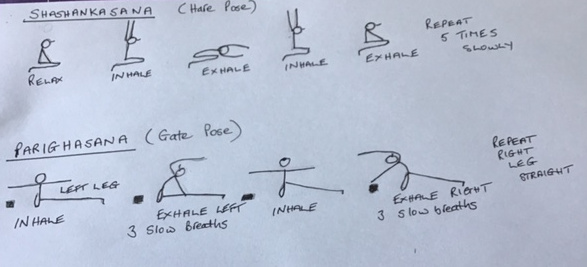
March is the beginning of Spring as it brings the Equinox, 20th March 2023. March is associated with awakening, renewal and fresh optimism.
The earth is coming alive again. The dark months are now over and we are moving into the warmth of the light.
Spring cleaning isn’t about sorting through things and getting rid of clutter. It is about taking stock of who you are, and how others see you. It is a chance to redefine yourself, to change expectations, and to remember that it’s never too late to recapture who you were, or to aim for who you want to be.
Asanas associated with March are the Mad March Hare (Shashank asana). Shash = hare and ank = lap. Forward bending in this poise lets us rest on our lap which mimics the appearance of a hare. Hands and forehead resting on the mat in front of knees and hold for 5 seconds. Inhale and slowly raise arms and trunk and exhale as you lower arms and hands to knees. This is one round. Five rounds is very beneficial as it stretches back muscles, tones pelvic muscles and sciatic nerves. See drawings.
Another pose for the month of March is Gate Pose (Parighasana). Parigha means ‘the bar used for shutting a gate’. The body resembles that cross beam. This pose is an energizing side body and pelvis stretch that will make you feel lighter. It also helps to strengthen the wrists, arms and legs and stretches the intercostal muscles that connect the ribs. Stretching the rib cage is the perfect posture to help us transition to and welcome Spring as it expands the breath throughout the entire torso. Start in a kneeling upright position and stretch out your left leg. See drawings.
Spring is slowly arriving. We are all aware of the lengthening days and the flurry of the birds pairing up. Our gardens are beginning to have all manner of shoots popping up and colour at last is there for us to gaze at. Everything is waking up after a long cold winter!
Yours in Yoga Anne
February 2023 Theme
Let There Be Light by Christine Royle
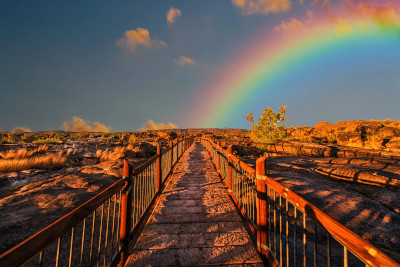
February is the time when the light is returning. The days are getting longer.
It is the quickening of the year, the first foetal stirrings of Spring. Mother Earth is wakening up as the light energy is warming her. The first awakening is the sign of the snowdrop. A delicate flower, but very strong and beautiful. In the old beliefs we call it Candlemas on February 2nd. It is celebrated with lots of candles burning to welcome the light.
We are just coming out of the harsh Winter months and looking forward to Spring.
During the dark winter months some people can feel depressed and suffer from Sad Disease, (Seasonal Affective Disease).
So how can Yoga help with this problem during the Wintertime when the light is not strong?
We know our Chakras are the colours of the spectrum of light.
Sit in a comfortable position for meditation.
Practice your yoga slow breathing. Making the exhalation longer than the inhalation to quieten the mind and focus within.
Then imagine you are surrounded by a Rainbow, all the colours of the spectrum of light.
Think of the colour red and breathe it into your mind on the inhalation. Then exhale the colour down the body to the base Chakra. Let this red flow and fill the base Chakra with warmth.
Continue with each colour of the Rainbow and direct the colour down to each Chakra.
The mind controls the body and the body responds filling you with light energy uplifting your mind and spirits.
As the light gets stronger, try, and go out into the light for walks feeling the warmth of the sun on your face and body, connecting with nature and watching the changes in the seasons.
We all know how heathy and energised we feel in the Summer time, this is because our Chakras are taking in the light energy.
So In the Winter don’t be feel down and depressed “WALK THE RAINBOW”. Look forward to the Spring.
Enjoy!
Love and Bright Blessings,
Christine.
CYTA Chair.
January 2023 Theme by Bridget Laing

January traditionally the month of new beginnings, setting your intentions or goals for the coming year but also a reflection on the year that has gone as in Charlotte Brontë’s quote below
The first day of January always presents to my mind a train of very solemn and important reflections and a question more easily asked than answered frequently occurs viz: How have I improved the past year and with what good intentions do I view the dawn of its successor?”
– Charlotte Brontë
A time for looking back but also leaving behind what no longer serves you, a time to meditate on things that were obstacles in the past year and how you overcame them or are you still carrying them with you as unwanted baggage, time to let these go and look forward to a new year of opportunities.
Perhaps a new practice focusing on going back to the basics or a simple mediation on the breath, slowing us down after the busyness of the Christmas holidays but also on that sense of goodwill continuing throughout the year and not just for Christmas.
A basic practice to start the day

Repeat 3 times focusing on the breath
Simple meditation on the breath
Sit comfortably in any seated position you prefer, hands placed on your knees in any mudra of your choice.
Gently close your eyes, give yourself permission to let go of the thoughts of the any daily activities and concerns. Be aware of your body and the space it occupies, begin to relax.
Be aware of your head & face let all the muscles in your face relax
Move down the body slowly, relaxing the muscles in your neck, chest, abdomen, arms & legs
Letting everything go, become aware of your breathing as you breath quietly through your nose
Breath deeply & evenly without straining, as you inhale allow the chest & abdomen to move out away from the spine & on the out breath in towards the spine. Try to keep the in & out breath the same length and try not to pause in between the in or out breath.
Bring your attention to the tip of your nose and as you breathe in follow it to your third eye the space between your eyebrows, the cool air going in and then as you breath out follow it back down to the tip of your nose, the warm air flowing out.
If your mind starts to wander bring it back to the breath up & down the nose and try adding counting down to 50, in on 50 out on 49 until you reach 20 then count down to 1 breath in & out to 19, 18 and so on.
When you’ve finished, let go of the traveling breath & just sit quietly for a while, letting the daily sounds filter in.
And embrace William Arthur Ward’s poem a Fresh New Year
Christmas Eve Meditation for December 2022 by Sue Hargreaves

Time your meditation to suit yourself (between the times of 7 and 9pm if possible).
Give yourself 10 minutes minimum for your meditation.
Having seated yourself comfortably, feel yourself relaxing as you focus on the breath. As you breathe steadily , be aware of Vishuddha Chakra ( Throat centre) allowing yourself to feel an opening and awareness of a blue light. Feel that you are slowly becoming surrounded by blue light which starts at the crown and spreads completely around your body. Visualise this light as a healing that you wish to share with those you care for and for the entire planet.
Think of your immediate family, and send out a message of love & peace.
Think of your extended family and send out thoughts of healing and peace
Think of neighbours and colleagues and send out thoughts of healing and peace
Now think of friends and acquaintances and maybe people you do not get on with, and
send out thoughts of healing and peace.
Now think of places you have seen and people you have met , and send them a message of healing and peace
Visualise the planet earth and surround it in an aura of blue light. Allow that light to fill the planet with peace and healing, and repeat to yourself,
I send peace and healing to planet earth
Visualise people on the planet and send out blue light to them, and repeat to yourself,
I send peace and healing to mankind
Feel the release of anything you no longer need to hold on to and feel the openness it gives.
Allow yourself to embrace the healing that is being sent to you by others.
Receive the calmness, balance and courage that comes from meditation as the blue light dissipates.
Then establish a calm and focused breath.
Slowly close down each chakra from the crown to the base, sealing it with a cross or a kiss.
Continue the calm and focused breath and bring yourself back to your base/ root/ what you are sitting on, safe and secure.
Om Shanti
Love and Light to you at this special time of year
Enjoy yourselves and be happy
Sue
CYTA monthly theme November 2022
by Judith Lynch
Daylight is much shorter this month but the leaves of the deciduous trees may still bring some brightness. If we wrap up warm we can enjoy being outdoors. Gardening is invigorating and we can practise the art of patience– our hard work will pay off in Spring.
Autumn in yoga is associated with letting go – allowing the element of air to lift us and enable us to move more freely and welcome new beginnings. The air element is linked to anahata, the heart chakra. So it is appropriate to practise postures which allow freedom in movement as well as those which open the chest and heart space. I rather like the phrase “Lift the sternum, lift the spirits”
Short Autumn asana practice and visualisation
- Seated, hands over heart, palms down. Visualise your heart pumping to circulate blood around your body. (You can extend this into the eagle mudra, crossing hands at wrists and linking thumbs then lift hands little way from chest. As exhale curl fingers, then stretch fingers like eagle wings on inhale. Repeat for 10 breaths)
Hands over heart give thanks for your hard working heart and the gift of breath.
- Gentle side bends and twists from any seated position
- Standing warm-ups, focussing on chest openers. NB Please practise these and any other chest opening asanas below as preparation for Alison Dyke’s chanting session on CYTA Zoom 19th November, if you are attending.
- Cross arms over chest, hug yourself then fling arms wide out to sides, opening chest. At same time laugh out loud. Repeat x3.
- “Figure of 8”. Cross arms as bend forward with bent knees. Lift up crossing again then opening arms wide above head into gentle backbend. Repeat x3
- Link fingers behind back, stretching hands towards heels, rolling shoulders back. Open chest without pushing stomach or hips forward. Release, hang forward.
- Asanas to encourage freedom of movement and breath
- Moving Eagle pose. Adopt usual balance posture then maybe add flow. As inhale unwrap arms and fling out to side or reach overhead and at same time step out to side with your top leg. As exhale wrap arms and legs again with opposite arm and leg on top. Repeat.
- Gentle swing twist. Focus on softness and relish the freedom of movement.
- Utthita Parsvakanasana. Extended side angle pose. Breathe deeply to support posture. Can add flow if you wish by lifting into Warrior 2 as inhale and back into side extension as breathe out. Makes space in trunk for efficient breath.
- Chest/heart opening postures
- Cow face pose/ Gomukhasana . Modify if need to. Widen across your collar bones, lift crown. Counters slouch and frees up tension in shoulders/neck/upper back.
- Bridge posture. Maybe stretch arms over head. Breathe deeply into chest area at top of posture.
- Matsyasana – the fish pose. Heart is the highest point in body. Let soft breath bring lightness/space into the heart area. Be aware of your heart beat and its energy.
- Seated – flop forward for a moment or two over deeply bent knees or rest in child’s pose.
Autumn Visualisation
Settle yourself in savasana. Remember it is a posture in its own right. Be aligned. Make sure you are warm and comfortable. Scan your body and soften into any areas of constriction. Observe your breathing and let go of any persistent thoughts.
Imagine yourself walking in the woods on a warm Autumn day. The sun is shining. Look up and see the sun illuminating the oranges, reds and browns of the leaves in the trees above you. There is a light breeze which creates a whispering sound in the trees. As you walk along see a leaf flutter from its tree and float slowly and gracefully down to the ground. Then you hear a conker disturbed by a gust of wind land with a plop alongside the leaf.
Walk on now and as you walk listen to the gentle rustling of the dry leaves at your feet. Breathe in deeply and enjoy the smell of the damp mellowness of the season. After a while you come across a large oak tree. It is dramatic in its size and strength. See its branches stretch upwards into the sky and its roots spread out wide across your path.
Approach the tree and sit down between its roots so that they form a comforting enclave. Support your back on the bark of the tree’s warm trunk. Feel part of the tree and enjoy its sense of strength and comfort. The tree exudes energy. Allow yourself time to share the energy the tree offers as you continue to rest and relax.
Judith Lynch (after Gill Bruton)
CYTA monthly theme October 2022
by Judith Lynch
Recently some members have requested that Cyta provide more yoga sequences. The committee have done so from time to time this year via this theme page. This month will be dedicated to some more posture sequences with which you may or may not be familiar. If you attended the recent Cyta Training Day you may have picked up a copy of a handout I provided, courtesy of Pam Horton, of a seated sun salutation. If not and you are unable to find this elsewhere I may be able to help.
Other sequences you may know are also like moving meditations. As such I find them useful as standing warm-up exercises but also for mind/body awareness. Focus, as in the seated sun salutation, is inward and mindful, with slow steady breathing and full synchronisation of the breath and the movement. I list some below you may be interested in, or perhaps you will find helpful to be reminded of:
Tai chi breathing sequences.
There are lots of these available to view on tai chi u tube clips. The version I like though is perhaps a fuller sequence.
- Stand calmly with feet slightly apart. Take your attention inwards and observe for a moment the flow of your breath. Breathe in raising arms one by one in front of your body, following with your eyes, then lower on exhalation. Now lift both arms and lean backwards. Lift upright and lower arms to your sides as you breathe out.
- Widen stance a little, turning toes out. Turn to face right leg, hanging forward as exhale, then lift uncurling on inhalation turning to centre. Repeat over left leg.
- Return to centre, join hands behind back and turn to R again to complete a flat back forward bend over leg then stay with head down and swing over L leg. Lift from there and repeat over L leg and then R leg once more.
- Upright again bring feet closer together to complete two balances. Breathing in come onto tiptoes and lower. Second time raise arms above your head.
- The sequence completes with hands held behind your back again moving into a soft forward bend with knees bent deeply and then releasing arms and head to hang relaxed. Breathe in and come up slowly bringing hands to prayer position at chest. Take a moment or two to reflect on how you feel, maybe lowering chin or closing eyes. This sequence is enhanced by practising to appropriate music, such as Buddhist chants (subject to copyright restrictions in classes of course)
Salute to the earth
I believe there are a number of versions of this sequence. I like the sense of grounding this brings and the variety of movements. Apologies for the poor stick drawings!

Moving tadasana sequence
- Stand tall in tadasana but with feet up to hip-width apart. Relax your knees and feel the weight dropping down to your feet, become more grounded. Tune into your breathing and notice the breath at your abdomen.
- Lift soft arms up front of body to shoulder level and down. Repeat twice in time with breath. Now raise soft arms above head and lower 3 times. Follow the hands with your eyes and ensure you are working with abdominal breathing, deepening as required and synchronising the flow of the breath perfectly with the movements.
- Repeat the arm movements, this time coming onto tiptoes and lowering heels slowly as you exhale and lower arms.
- Third movement is a knee bend/mini squat on the out breath as you lower arms.
- At the end of the sequence hold the squat with hands resting on your thighs. At this point I like to ask students which part(s) of their body feels the strongest sensation. The answers are interesting and usually varied which can provide opportunity for further discussion.
September 2022 theme – a practice for pacifying the Ayurvedic Vata dosha.
As we move into autumn with its cooler and windier weather it may be helpful to focus our practice on pacifying the Ayurvedic vata dosha. The suggested lesson plan below should take less than hour to complete with ease, allowing time for a lengthy relaxation.
When the vata dosha is out of balance it can lead to anxiety, restlessness, fatigue or hyperactivity and digestive problems.
Pacifying vata through postures, diet and breathing exercises helps to calm the nervous system, keying into the benefits of the energy of the element of air, flowing movements and a sense of creativity and connection. Practising stillness, long holds and restful postures, particularly focussing on grounding and slow movements around the hips, pelvis and lower back are the order of the day.
Seated centring.
- Relax arms, shoulders, face.
- Relax buttocks, allow hips to soften and the whole of lower trunk to sink and spread into the mat as you exhale.
- As you breathe in engage your pelvic floor muscles and focus on imagining air rising up through the root chakra into the sacral chakra.
- Breathe out keeping your focus on your lower trunk, relaxing pelvic floor muscles, hips and buttock muscles. Think of roots going down from your perineum into the mat and floor beneath you giving you stability and a sense of being held by the earth beneath you.
- As you breathe in again engage the strength in your lower abdominal and spinal area. Repeat once more.
Figure of eight with eyes.
Lying
- Rock raised knees from side to side. Head opposite way.
- Lying tree- Hold posture on each side. Imagine taking your breath in through the sole of the extended foot, up the side of trunk and head to the crown of head and flowing back down again as you exhale.
- Hamstring stretches
- Alternate hip circles, slowly as if the knee has a pencil attached, drawing circles on ceiling
- Hold alternate knees to chest to stretch out lumber area, then hug both knees in.
- Full body stretch
Seated
- Diamond legs twist, raising arms in centre, lowering one hand to knee and one to floor behind you.
- Full cobbler. Butterfly rock then into forward and back bend
Standing
- Tadasana – focus on stability – grounding through 4 corners of feet, lift arches, lengthen up from inner ankles.
- Also strength in knees and thighs, hips, pelvic muscles which provides even more stability.
- Think of rooting down once more, then lengthening up. “Ground down into tadasana to connect with your root chakra”
- Tree – any version, focusing on grounding and opening hips.
- Windmilling side bends – for stability in feet/legs and core and also for flowing movement
- Hang forward, (bent knees,) hold elbows. Maintain hold if comfortable. Remember forward bends are helpful as they are restful and comforting.
Lying on front – back strengthening – lifting arms, then legs, then both together if you wish
Low lunge – any version
Pose of the child
Relaxation – make this lengthy for full benefit
Savasana is of course both a spinal alignment and a grounding posture. Soften and let go of any physical, mental or emotional tension, relaxing into the supporting arms of the earth beneath you.
Focus on the flow of your breath. Take 3 breaths in through your nose, sighing out slowly through your mouth. Take your time to move towards stillness in your body and to calm your thoughts. Just let any persistent thoughts go by acknowledging each thought and then letting it simply float away, focusing your attention once more on the natural flow of your breath. After all you can only be aware of one breath at a time – the true power of now – being aware of one moment at a time.
A breathing technique which increases cool energy is to breathe in for a slow count of 2 and out for a slow count of 4. Try that out and if you feel comfortable with it you can of course increase the ratio to 3/6 and then perhaps even 4/8. This breath pattern also helps with relaxation as the longer, slower out breath of course allows your whole self to rest and relax more deeply.
Relax, relax, relax……
If you are concerned that this focus on slow, mindful activity and stillness might inhibit your sense of creativity, fun and connection I offer the following quote:
“Flying starts from the ground. The more grounded you are the higher you fly”
Quote from J. R. Rim
September theme author: Judith Lynch
August Theme
Enjoy your garden sanctuary this month. These are recent photos of Judith Lynch’s garden. Do you have any photos of your garden sanctuary to share on line? If so please send to the CYTA Website Administrator (chrissmith0161 -at- gmail.com) and he will add them to this article. Please click on the images to view a larger version and scroll through. Thank you.
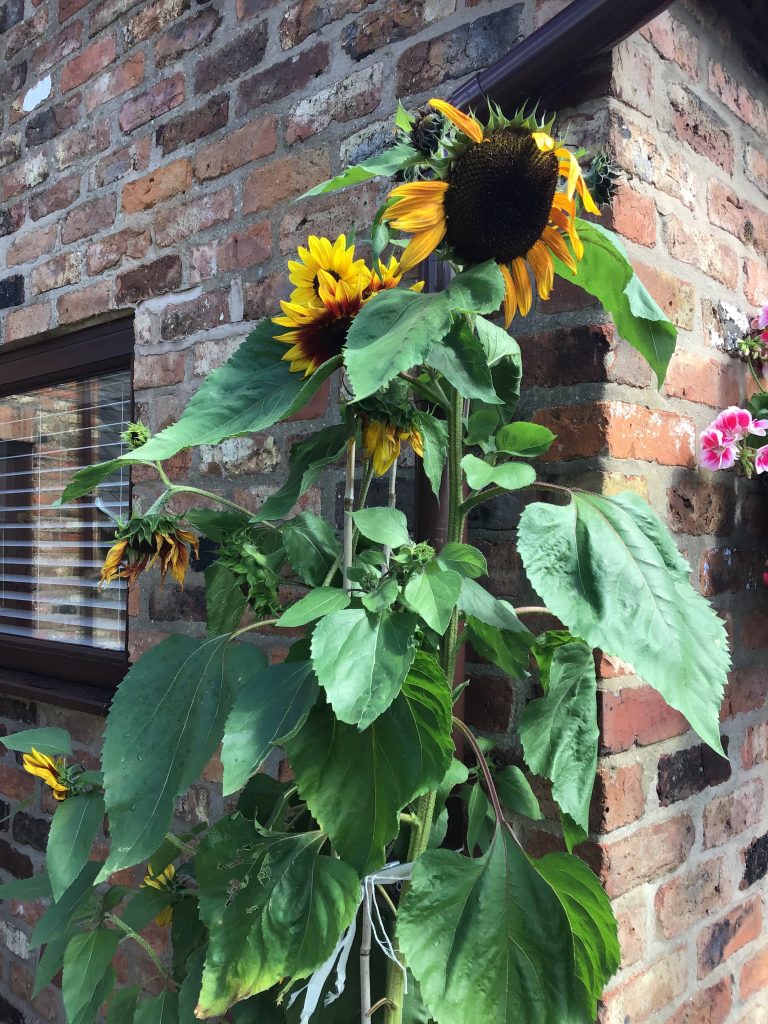

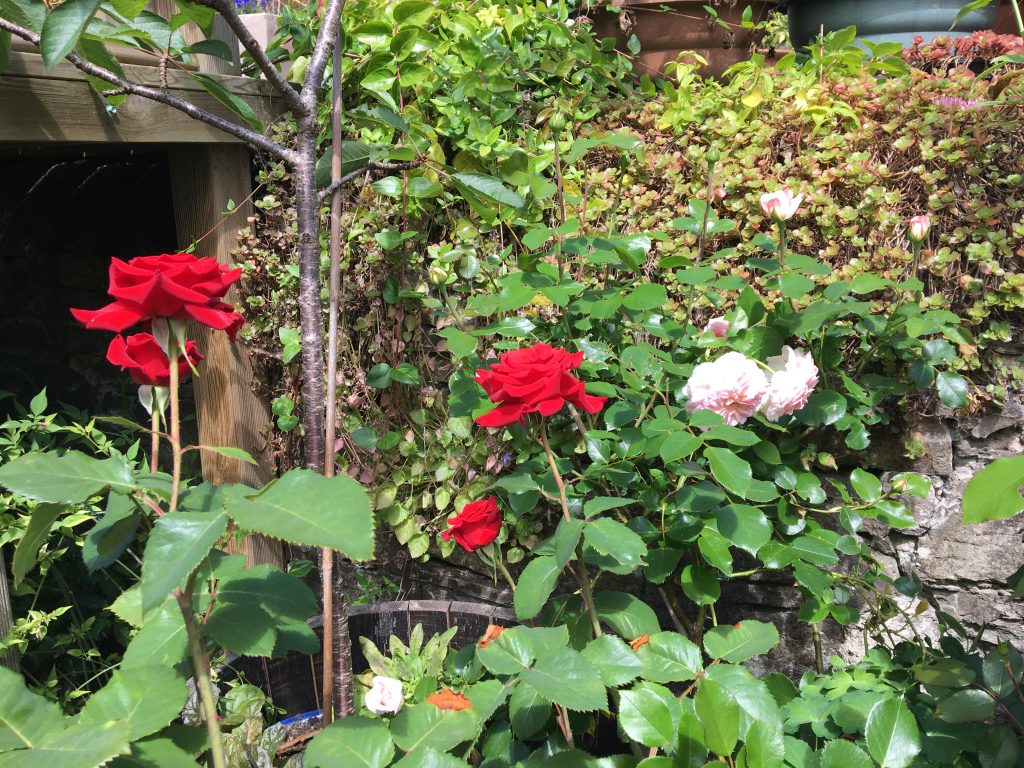
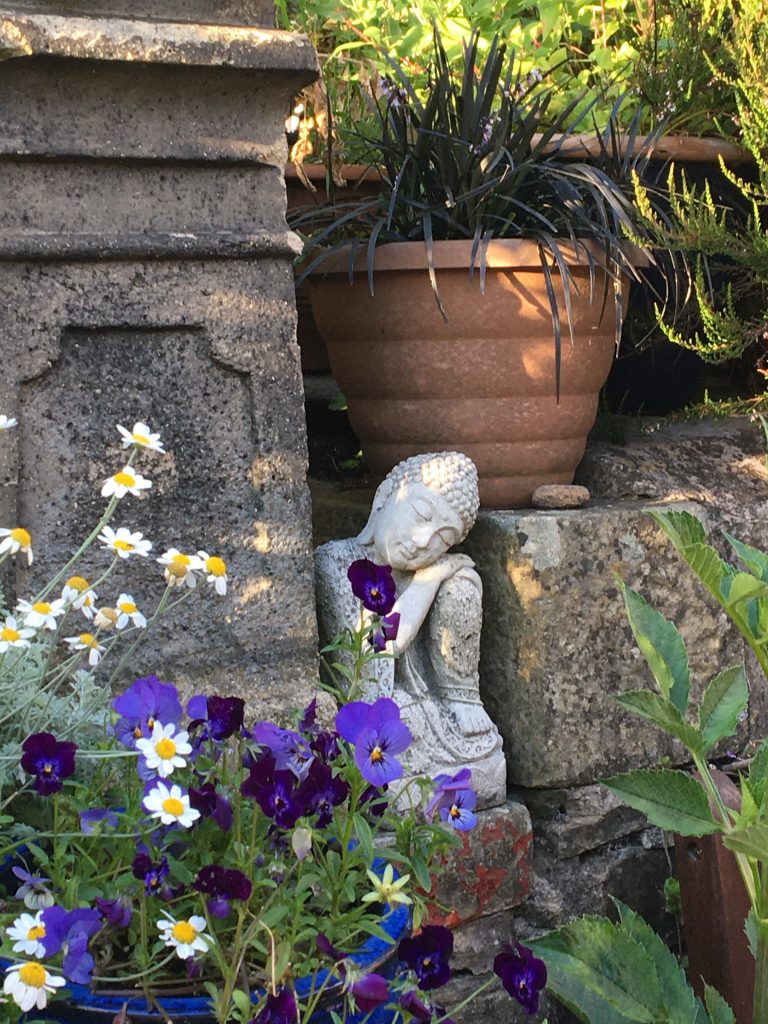
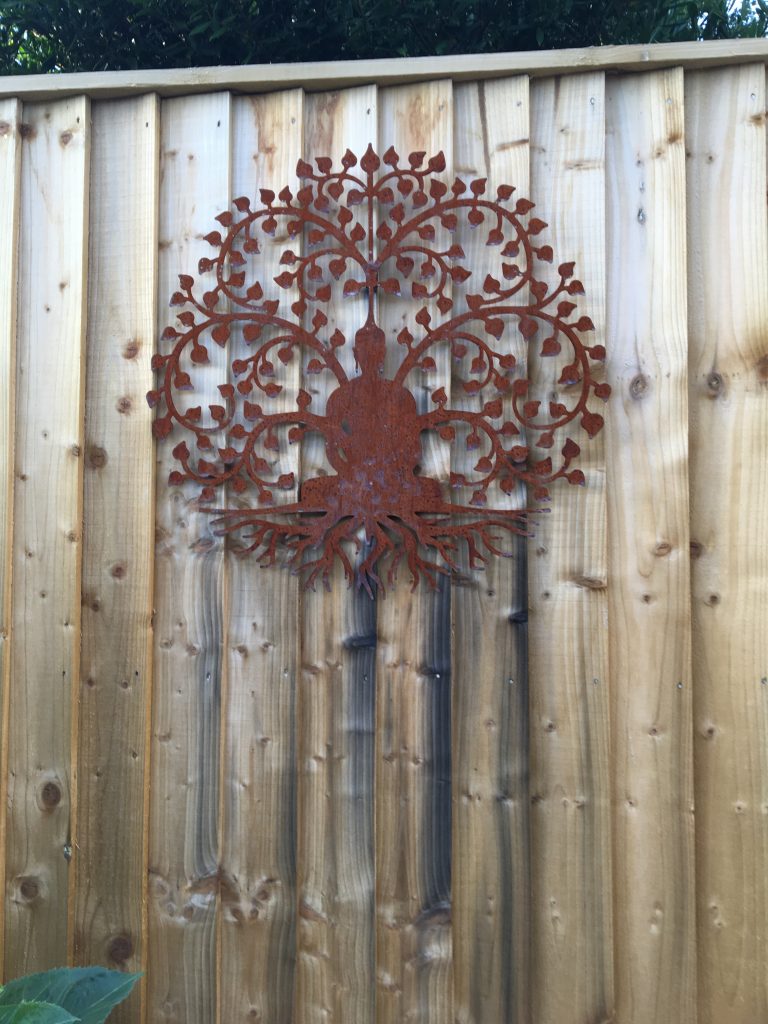

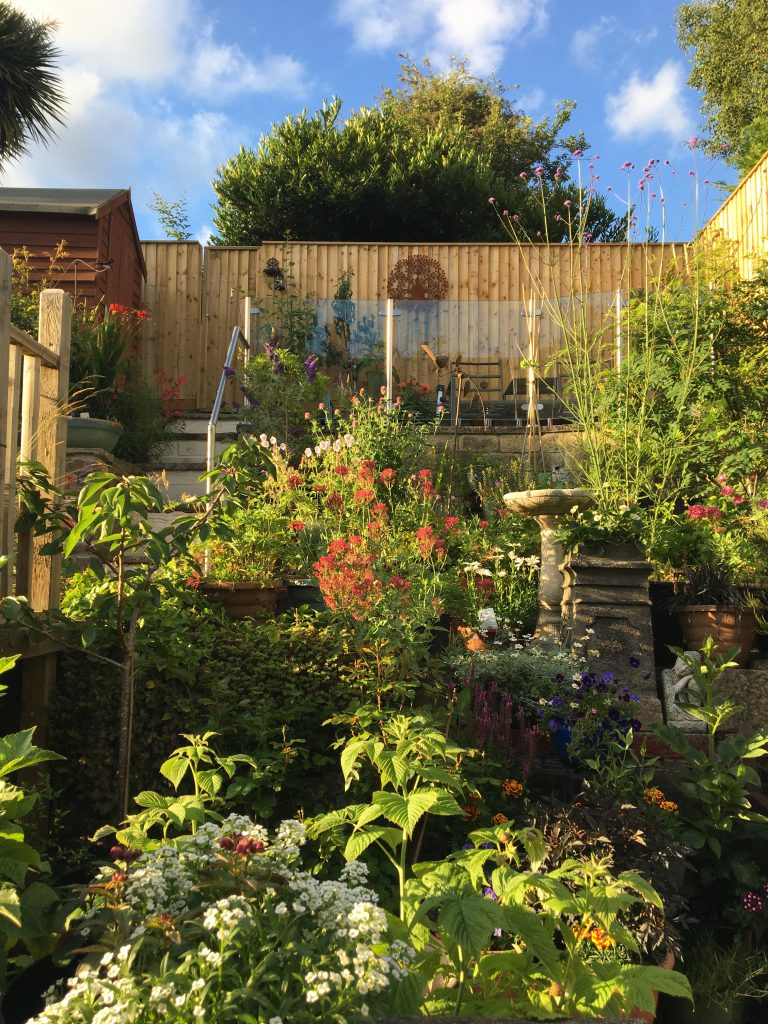

July Theme
This month our gardens and countryside are coming into full bloom. I hope you can make time to get out and enjoy these open spaces. The RHS list a number of recommended sensory plants to consider planting for your garden, or in pots. These can help to develop your garden as a personal sanctuary by creating sensory relaxation. Many also attract bees and butterflies.
Buddleia . The Butterfly Candy series is suitable for pots and comes in a variety of colours – I have had 3 healthy pot plants flowering well for at least 7 years.
Eucalyptus gunni “Azura” Aromatic leaves and bee friendly flowers
Rosemary – for herbal teas, soups and stews. Aromatic leaves release scent when touched
Rosa “Sparkle” – for its scent and bright orange colour
Lavender- said to be invaluable in a mindful garden with soft scented leaves and pollinator-friendly flowers
Rose and lavender are said to be therapeutic – helping support memory, reduce anxiety and improve sleep
Perhaps in your yoga practise or teaching this month you can include the use of essential oils, such as lavender. Or simply wander around your garden breathing in deeply the aromas of the plants. As well as flowers and herbs we have the trees to admire in all their power and glory at this time of year.
Why not focus on practising the tree posture this month. A useful warm-up for the standing tree posture is practising the lying tree. You can take your arms over your head if you wish with palms together hands on crown of head, if preferred. However consider softness and stillness in this posture, focussing on releasing any tightness in the hip, groin and shoulder areas. You may be aware there are several ways to access the full tree posture which can help you to balance more readily and improve the posture overall. You can try starting with the heel of the non-standing leg propped next to the ankle of the supporting leg, toes on the floor. This way you can work on taking the knee out to the side and strengthening the standing leg without worrying about your balance. Next you can either swap legs and repeat on that side or else move onto stage two on the same leg i.e. placing foot at calf/knee or thigh and introducing the balance element. Stage 3 is then to open chest and raise arms above head, palms together with bent elbows if you prefer. An alternative I have enjoyed practising and teaching is the dancing tree posture. This involves stepping from side to side repeatedly lifting alternate legs and then maybe adding on by lifting alternate or both arms. Taking weight from one foot to the other repeatedly seems to help some people to balance more readily and thereby increase their enjoyment practising the posture.
Returning to flowers why not make use of Audrey Youngman’s lovely visualisation of a walk on a summer’s day – see below. This picks up on the sensory aspects of spring and summer flowers observed on the walk and you will spot it also reflects the colours related to the chakras. Thank you very much to Audrey for allowing CYTA to reproduce her personal visualisation for CYTA members to share and enjoy. Some of you may recognise it as Audrey took us through it at a CYTA event in March 2016.
Relaxation/Visualisation
Settle yourself in your best balanced position for savasana . Make sure you are warm and comfortable with spine aligned and relax into your mat. Close your eyes softly and relax your face, especially your jaw. Relax into any tight areas you observe in your body. Use tense and relax technique for your limbs if you wish. Observe your breathing and allow it to settle into a gentle soft flow, feeling the temperature of the air at your nostrils.
Imagine a warm summer’s day. You are walking along a country lane. Feel the warmth of the sun on your face and arms. After a while you come to a stile. Climb over it into a field and see a lovely red rose. Stop to admire its beauty, feel the softness of its petals, bend down to smell its perfume. Then you spot a patch of beautiful orange marigolds, their open flowers looking like the sun itself. Walk on across the field to another patch of flowers – some late daffodils, their faces looking up and gently dancing in the warm breeze. Slip your shoes off and walk across the grass, feel the springyness of its texture and see its bright green colour. Look up to a brilliant blue sky. At the far side of the field there are some irises and just tucked in behind them see a tiny violet.
Continue walking the footpath ahead and feel a sense of tranquillity and peace. Breathe in deeply and absorb the warmth, stillness and peace. All is right with your world. Turn now and walk back through your field of flowers. Approach the stile and as you climb over it, back into everyday life, make an affirmation to come back to these moments of peace and tranquillity throughout the coming week.
Notice yourself lying on the mat. With eyes still closed bring your awareness to your surroundings. Take some deeper breaths. Begin some gentle movements and in your own time stretch out and then bring knees to chest and roll onto your side and then come back slowly to a seated position, eyes still closed. Rub your hands together and palm them over your closed eyes. Open eyes and separate fingers slowly, releasing hands to lap and chin to chest. Breathe in deeply and raise your head.February 2023 ThemeNotice yourself lying on the mat. With eyes still closed bring your awareness to your surroundings. Take some deeper breaths. Begin some gentle movements and in your own time stretch out and then bring knees to chest and roll onto your side and then come back slowly to a seated position, eyes still closed. Rub your hands together and palm them over your closed eyes. Open eyes and separate fingers slowly, releasing hands to lap and chin to chest. Breathe in deeply and raise your head.
Thanks again to Audrey for sharing her visualisation.
June Theme
Words by Judith Lynch, Sue Hargreaves and Jackie Hudson.
Now that the warmer weather is finally with us have you noticed the bees, butterflies and other insects emerging and looking to pollinate plants and help nature in other ways? Perhaps you have been lucky enough to enjoy seeing some ducklings, goslings or even cygnets. Or maybe you spotted a baby badger or even a hedgehog. Recently, in the Lake District, I glimpsed a red squirrel and a stoat and admired a colourful pheasant, while my daughter-in-law was amazed to see a slow worm. There is new life to admire all around us both in the animal world and in the plant world. The bulbs and forget-me- nots have now died back but the perennials and annuals are emerging to fill the gaps in the landscape and in our gardens. Flowering shrubs and blossom trees delight the senses. The landscape is a glorious shade of green. The birds are singing loudly, feeding well and sitting on their eggs. Cats and dogs are lounging in the sunshine.
So how about this month focusing on practicing asanas with animal names? Obviously these names of postures are direct translations from the Sanskrit. It is thought that the ancient yogis were so close to nature that they wished to imitate animals and other natural phenomena in their asanas. They could see that animals are able to naturally release any tension and enjoy the benefits of stillness. By holding postures in these shapes they hoped to gain these benefits for themselves. Animal shaped asanas can of course be put together in a sequence or mixed them with other postures. Obvious choices are downward and upward dog postures maybe with a counter-pose of the swan. You could also combine cat and dog posture with swan or child posture. Additional postures to add on to either could be standing forward bend and/or plank.
Jackie Hudson has kindly put together a couple of other sequences for you to follow below:
February 2023 Theme
May Theme: “Ne’re cast a clout ’till May is out…”
Words by Sue Hargreaves and Judith Lynch
You might notice a chill in the air some days this month.
The saying above was first published in 1792 and then appeared in the Whitby Gazette in 1855. It has several meanings. Since the early 15th century the word clout has been used to describe a fragment of cloth or clothing. This is where the saying took on 2 meanings.
The new one was a reminder not to take off warmer clothes until cooler May was over and summer began. However, this would mean the farm workers suffering in the fields if they did keep all their winter clothes on throughout the whole of May, and the blossoming of the May flower/ Hawthorne was a better indicator of the weather.
The original meaning goes back to Medieval times when a May flower/ Hawthorne branch was left at the door of the beloved on May 1st, to propose marriage. If she left the branch at the door, then the proposal was accepted. The other May birth flower is Lily of the Valley which is favoured for bridal bouquets. Both flowers are associated with hope, happiness and humility.
Given the remaining nip in the air in late Spring some energising and warming sequences might be helpful. As well as enjoying flowing Sun Salutations of various kinds perhaps consider the Tibetan Rites for Health and Vitality. You can look online to find out about this sequence of movements and how best to build up repetitions if you are not familiar with them. I would recommend a slow start of 3/5 repetitions of each posture, making sure you relax for a few breaths between each exercise. Teachers can consider different approaches to practising these movements. They can be used as class warm-ups, leading onto stronger similar yoga postures. Appropriate counter poses and relaxations between the movements can also be developed.
Yoga teachers might also like to write a visualisation based on the two May flowers, focussing on the senses and/or linking to the lowest 3 chakras and the idea of rising energy in Spring and also contentment with what life offers.
“Be content with what you have;
Rejoice in the way things are.
When you realize there is nothing lacking,
The whole world belongs to you.”
Lao Tzu (604-531)
Taoist Philosopher
April Theme: Gardens- a sanctuary
Words by Sue Hargreaves
We all have a need for balance in our lives. We are compelled to do , but we also need to be. As many have said, we become human doings instead of human beings. Being, means the occasional retreat from the front lines of life.
A sanctuary garden allows us to be both doing and being, to find a natural balance. But we have to incorporate opportunities to just be. Sitting areas are important . Also meandering paths. Features such as a pond, tree, water feature, can draw us to sit quietly. Lastly, a hidden area is the perfect place for solitude and reflection.
The creation of a sanctuary, sets in motion spiritual energy. This is the natural outcome of defining a boundary or space with reverent intent , and creating what the ancient Greeks called tememos, or ‘sacred enclosure’. Like a shrine, it becomes empowered by repeated visits , by good deeds, by the desire to honour the nature of spirit and the spirit of Nature , in their most simple or complex forms.
Creating an entrance to your sanctuary space – a specific spot that you pass through- can give the feeling of separation from the hub-bub of the world. Arched entrances created with curving branches, wrought iron, climbing plants, potted plants or a leafy tree branch to walk under accentuate the drama.
The entrance is enhanced by a feeling of enclosure around your space . It can be formal , as with a fence, or implied, with a visual screen of plants. A fence should be as natural as possible – natural wood, branches, bamboo, hedge, trellis. Use of a gate should reflect your personality – is it to be solid, blocking the view in? Or more open, to offer a glimpse of within.
You could hang a sanctuary sign, an inspiring quote, a welcoming thought, or the name of your space. This gives time to pause at the threshold. Or it could be a focal point – a large leaved plant, a bench, a large boulder, a piece of garden art/ sculpture, a water feature, a specimen tree/ shrub, seasonal flower planters, the framing of the view ahead.
Lighting establishes a mood. Consider natural light- bright sunlight , filtered light or mostly shade. Night lighting around the entrance , along the path, of spotlighting a feature encourages evening visits to the garden. If your garden has shade incorporate some brighter leaved / flowered plants.
If possible , let a pathway leading to and beyond the entrance be meandering and winding , rather than always straight. This creates intrigue and makes it feel more spacious and relaxed. If a straight path is unavoidable, make the path itself more artistic- stepping stones,mossy interplantings, different textures, changes of level. You can let plants creep over the edge , out of the side borders, creating an illusion of varied pathway.
Colour is naturally therapeutic , healing and spiritually deepening. You may be drawn to certain colours. Reflect on the mood and feelings you want in your space and keep it simple, using only 2 or 3 colours in a given area. Sit and note the effect of light on the colour and texture of the plants. Let different colours / blossom arise to subtly evoke a different mood. Be sure that leaves and foliage are considered as these can last longer than the flowers/ blossom.
Remember to match the flowering times and consider planting for sequential flowering throughout the season and know what your plants need for growth and vitality. As plants mature at different heights and widths, be sure that more vigorous ones don’t smother the delicate ones.
Water is key to sanctuary. Its sacred influence over human history is unmatched among all other natural forces.
Shallow water bowls , with partially submerged stones, are important perches and sunning spots for butterflies , bees, insects and some birds. Also, bird baths.
Natural catch basins – hollowed rock and indented surfaces – are natural water features.
Fountains are powerful focal points.
Locate a sitting area nearby for your enjoyment. Let the view be inspiring and free of clutter. If you have more than one sitting area, let each reflect a different mood or purpose. Consider the following : meditation and contemplation, a shady retreat spot, tea and conversation, sunset viewing, outdoor dining, wildlife viewing, flower gazing, taking in the fragrance of a favourite plant. Whatever you create , sit there often, letting it become saturated with peace and gratitude.
As far as yogic practices are concerned the quiet sitting area is obviously ideal for meditation and relaxation. If you are teaching you may wish to put together a visualisation based on your experiences of sitting in your sanctuary to share with your students. You could also choose to link your meditation or asana practice in the garden to one or two of the elements such as water or earth or to focus on one of the colours associated with a particular chakra centre where it is replicated in the flora and fauna around you. If you have a secluded grassy space practising barefoot allows you to really feel in contact with the earth beneath you and to feel more grounded. Even hard landscaped areas can be used for standing poses. Feel the earth beneath you, the warmth of the sun on your skin, the breeze in your hair. Look steadily at the horizon and enjoy all the sensations around you in your garden. Trikonasana is a particularly lovely asana to practise outdoors feeling the support of the ground and your legs beneath you as your upper trunk opens to the sky. Feel the lightness in the upper body and possibly a slight movement in the breeze. Enjoy your garden sanctuary, alone or with friends.
March Theme
The beginning of March is the meteorological start of spring. Astronomically though it is linked to the Spring Equinox which falls this year on Sunday March 20th in the Northern hemisphere. On the equinox the daytime and night-time hours are nearly equal. You can enjoy viewing the Sun moving across the sky, birds migrating north or the March Full Moon called “Worm Moon” to reflect nature stirring underground. We start to enjoy even longer days and more warmth from the sun from now on. There are some ancient sacred sites and celebrations associated with the spring equinox eg Chichen Itza in Mexico with its fascinating Mayan pyramid and spring sun serpent. Egg balancing folklore is a 20th century tradition which obviously relates to Easter.
A possible yoga theme could be the element of water which early spring is associated with – the sense of flow and change in life and yoga postures. Smooth but simple yoga sequences or fluid vinyasas would fit here. Move slowly initially with ease and grace, using the strength of legs and the rhythm of the breath for support. Perhaps consider theming your class around the svadhishthana chakra. Flow and pelvic asanas would apply plus a link to balancing this chakra to allow us to be adaptable but also to enjoy the beauty and energy of life. Think about our relationship with Chandra – the Moon – and its influence on us in this context. Acknowledge our need to slow down, rest, re-energise and take care of our inner selves. Acknowledge our need to be strong enough to develop and accept change i.e. to go with the flow of life.
Alternatively you could be inspired by a sense of the rising energy in nature. Encourage students to be mindful of and enjoy signs of new beginnings and rebirth in nature, such as daffodils, the first green shoots, louder birdsong. Reading from and acknowledging our wonderful Romantic poems in class might be uplifting here. Or possibly write your own visualisation about the sap rising and/or sunrise and sunset at this time of the year.
February Theme – a cold winter month- but with a prelude to spring.
Anne Goldstraw had kindly sent a quotation for this month’s theme – ‘REST- before the onset of Spring’ . However, we could not include it as it would infringe copyright , but it did mention imbolc, and so I have picked up on that, and here is some information about it.
From February 1, through sundown, to February 2nd, our ancestors celebrated a festival called imbolc. Based on a Celtic tradition, imbolc was meant to mark the halfway point between the winter solstice and the spring equinox, and a celebration of the end of winter and the forthcoming lighter half of the year. It is just one of several pre- Christian festivals highlighting an aspect of winter and sunlight, and heralding the change of the seasons.
The name Imbolc originates from ‘i mbolg’, which translates as ‘in the belly’, referring to the livestock breeding season, particularly the pregnancy of ewes, one of the focal points of the celebration. As the festival was associated with this, it’s timing often varied – it could be anywhere from mid-January to mid- February.
With the introduction of Christianity, the festival was tied in with a celebration of Saint Bridget, and became a Christian one.Christians used Brigid as the focal point of celebrations, to smooth the transition from the pagan , as Imbolc had previously been associated with a goddess of a very similar name, Brighid. As with all Celtic festivals, Imbolc had a host of unique customs and rituals to say farewell to the winter and welcome spring, and to ward against evil and promote health and wellbeing.
Winter gives us the invitation to rest and be still, in preparation for the newness and feeling of a new start in the Spring, when everything suddenly springs into life.
January Theme
The Joy of Silence – abstracted from an article by Charles Brien. Late member of CYTA.
Following on from David Glover’s Zoom Meditation session I have abstracted some of Charels Brien’s thoughts from one of his articles, ‘The Joy of Silence’, from 1996 Yoga and Health publication.
Charles was a qualified BWY teacher who joined CYTA in 1988 and wrote articles for CYTA, BWY and other yoga publications. He designed the first CYTA membership card in 1993. He sadly died in 1998. Myself and members of the Committee spent time at CYTA events with him and enjoyed his teaching and sense of humour.
We live in a noisy world and are disturbed by intrusive sounds- lawnmowers, traffic, aircraft, domestic appliances, next door’s radio, phones. If you are looking for a quiet place to meditate , it may be hard to find.
For meditators, sound can be a distraction. The traction part of that word means grip, so distraction means losing your grip.
Saints and sages have taught that in silence we find spiritual strength and fulfilment. The Maitri Upanishad states:
“At the end of OM there is silence . It is the silence of joy.
When thoughts become silence, the soul finds peace in its own source.
When the mind is silent, beyond weakness or non concentration, then it can enter into a world which is far beyond the mind; the highest end. “
In those words, beyond weakness and non concentration, there is a clue to mastering distracting noise. Learning to focus on the subject of our meditation, so that we no longer hear the distracting noise. It is subtle process. Deepak Chopra described it as like creeping through a herd of sleeping elephants without waking them. What could be simpler? You might ask ‘ What could be more difficult?’
Somehow we have to quieten the 5 senses. The Katha Upanishad states :
“ When the 5 senses and mind are still, and reason itself rests in silence, then begins the Path Supreme”.
When I sit down to meditate , I close my eyes and focus on my breath.( This is what many of us are familiar with, and use) . It is a trick played upon the senses , which seems to muffle the disturbances which vie for attention: sounds, stray thoughts and physical sensations. The word disturbance comes from the latin dis meaning apart from , and turbare meaning to agitate. At the gates of our inner being we have noisy crowds clamoring for a hearing and by closing the shutters of our mind, we can distance ourselves from the disturbance. I find it helpful to look calmly at the would-be intruders and say to them “ I’m meditating now . I will talk to you later.” At the end of meditation I would then open the shutters and let pressing thoughts and feelings have time and space. Often they had melted away.
Poets and mystics, writing about the process of meditation , have referred to silent sound or silent music.
Many have associated this mysterious concept with the Heart Centre. Emily Bronte writes ‘Mute music soothes my breast unuttered harmony.’
How can sound be silent ? What is silent music? When one has practised meditation for a time, understanding begins to dawn. The Maitri Upanishad states:
“At the end of OM there is silence. It is the silence of joy.”
To test the truth of this ancient wisdom , one must meditate using the mantra OM whilst focusing on the inner self at the Heart Centre. After a while, let the sound imperceptibly fade away. Then you can hear silent music. I can only describe it as a silent vibration with light, ,love and joy. The bliss experienced in this moment of profound silence is a manifestation of Inner Divinity. The Chandogya Upanishad describes the process as :
“He who upholds the whole universe and in silence, is loving to all. This is the spirit that is in the heart, this is Brahman.”
Psalm 46-10 puts it more clearly:
“Be still and know that I am God”.
I think that this is what all the scriptures and books on meditation are saying – it is that simple. Would an omnipresent deity expect us to have an IQ of 150 to qualify for spiritual fulfilment?
Perhaps we should put our books away and get wise to silence. Sri Ramakrishna once said:
“The almanac forecasts the rainfall of the year. But not a drop of water will you get by squeezing the almanac . No, not even one drop.”
